NBER WORKING PAPER SERIES
INTERMEDIARIES IN INTERNATIONAL TRADE:
DIRECT VERSUS INDIRECT MODES OF EXPORT
Andrew B. Bernard
Marco Grazzi
Chiara Tomasi
Working Paper 17711
http://www.nber.org/papers/w17711
NATIONAL BUREAU OF ECONOMIC RESEARCH
1050 Massachusetts Avenue
Cambridge, MA 02138
December 2011
The present work has been possible thanks to a research agreement between the Italian Statistical Office
(ISTAT) and the Scuola Superiore Sant'Anna. Grazzi and Tomasi gratefully acknowledge financial
support from the European Commission 6th FP (Contract CIT3-CT-2005-513396), Project: DIME
- Dynamics of Institutions and Markets in Europe. Tomasi gratefully acknowledges financial support
by the Marie Curie Program Grant COFUND Provincia Autonoma di Trento. Bernard acknowledges
support from the European University Institute and the Tuck School of Business. The views expressed
herein are those of the authors and do not necessarily reflect the views of the National Bureau of Economic
Research.
NBER working papers are circulated for discussion and comment purposes. They have not been peer-
reviewed or been subject to the review by the NBER Board of Directors that accompanies official
NBER publications.
© 2011 by Andrew B. Bernard, Marco Grazzi, and Chiara Tomasi. All rights reserved. Short sections
of text, not to exceed two paragraphs, may be quoted without explicit permission provided that full
credit, including © notice, is given to the source.

Intermediaries in International Trade: Direct versus indirect modes of export
Andrew B. Bernard, Marco Grazzi, and Chiara Tomasi
NBER Working Paper No. 17711
December 2011
JEL No. D22,F12,F14,L22,L23
ABSTRACT
This paper examines the factors that give rise to intermediaries in exporting and explores the implications
for trade volumes. Export intermediaries such as wholesalers serve different markets and export different
products than manufacturing exporters. In particular, high market-specific fixed costs of exporting,
the (lack of) quality of the general contracting environment and product-specific factors play important
roles in explaining the existence of export intermediaries. These underlying differences between direct
and intermediary exporters have important consequences for trade flows. The ability of export intermediaries
to overcome country and product fixed costs means that they can more easily respond along the extensive
margin to external shocks. Intermediaries and direct exporters respond differently to exchange rate
fluctuations both in terms of the total value of shipments and the number of products exported as well
as in terms of prices and quantities. Aggregate exports to destinations with high shares of indirect
exports are much less responsive to changes in the real exchange rate than are exports to countries
served primarily by direct exporters.
Andrew B. Bernard
Tuck School of Business at Dartmouth
100 Tuck Hall
Hanover, NH 03755
and NBER
Marco Grazzi
LEM Scuola Superiore Sant'Anna
Piazza Martiri della Liberta', 33
56127 Pisa, Italy
Chiara Tomasi
University of Trento
Via Inama, 5
38122 Trento, Italy
and LEM Scuola Superiore Sant'Anna

Intermediaries in International Trade
1 Introduction
The growing availability of firm-level international trade data has contributed to th e blooming
of both theoretical and empirical literatures highlighting the importance of firm heterogeneity
in aggregate trade flows. Since the initial empirical papers of Bernard and Jensen (1995, 1999),
Roberts and Tybout (1997) and the theoretical models of Melitz (2003) and Bernard et al. (2003),
a major f ocus in international trade has been on the relationship between the characteristics of pro-
ducing firms, most notably productivity, and their participation in international trade. An emerging
stream of research has examined differences among trading firms (Bernard, Jensen, Redding and Schott;
2010b; Ahn et al.; 2011; Antr`as and C ostinot ; 2011). These papers emphasize that exporters in-
clude both manufacturing firms that organize the production and distribution of their goods abroad
as well as intermediaries that specialize in distribution in foreign markets.
In this paper, we examine the underlying factors that give rise to exports by intermediaries
and the consequences in terms of trade volumes and the margins of adjustment to external shocks.
Existing theoretical and empirical work on intermediaries in exporting emphasizes the importance
of country-sp ecific fi x ed export costs and the variation of intermediary export shares across desti-
nations. We extend that focus to include both broader country-level fi x ed costs as well as charac-
teristics of the produ cts themselves.
More importantly, this paper also considers additional implications of the lower fixed costs for
wholesale exporters. If export intermediaries do indeed face lower fixed costs of exporting then
they should also more easily enter and exit export markets in the face of changing profitability.
Firm-level export volumes shou ld respond differently for wholesale exporters and manufacturing
exporters. Aggregating to the country-level, th is firm-level variation implies differential changes in
exports between destinations served primarily by direct and indirect exporters.
Using Italian firm-level trade data, we investigate the importance of intermediaries (wholesalers)
in exports across destinations and products and examine how they differ from manufacturing firms
that export directly. More than one quarter of all exporters are intermediaries and they account
for over 10 percent of Italian exports. However, there is substantial variation in the importance of
intermediaries across countries and products. New Zealand and China have intermediary export
shares near 9 percent (25th percentile) while Paraguay and Malawi are at the 75th percentile with
shares above 23 percent.
Intermediary exporters differ in a number of dimensions from manufacturing firms that export
directly. They are smaller in terms of exports, sales and especially emp loyment as would be
expected since they are only involved in the cross-border distribution of the products and not the
production. However, wholesale exporters display h igher sales per emp loyee and comparable exports
per employee. On average, intermediary exporters reach fewer countries and ship more products
1

Intermediaries in International Trade
than do direct exporters. One important difference between wholesalers and manufacturers lies in
their tendency to ad d and drop products. Intermediaries add and drop prod ucts at much higher
rates than direct exporters. These firms face lower sunk costs of exporting and thus are able to
adjust their extensive margin more easily.
The existence of intermediaries suggests that they overcome barriers to international trade at a
lower cost than manufacturers for some range of goods and for some countries. We examine the role
of both countr y and product characteristics in the choice of the mode of export and the magnitude
of country-product exports. The finding of previous studies that country-specific fixed export costs
are corr elated with the u se of export intermediaries is confirmed in the Italian data. In addition, the
quality of the general contracting environment is related to the choice of mode of export. Exports
through an intermediary are more likely when the quality of the general contracting environment
of the country is weak. Product characteristics also play a role in determining the choice of export
mode. Lower contract intensity, greater product homogeneity, and higher produ ct-level sunk costs
of exporting are associated with a greater reliance on intermediaries in exporting.
The differences in fixed costs across destinations and products give rise to variation in response
to common external shocks to profitability such as exchange rates. Total exports by wholesalers
are less responsive to exchange rate changes precisely because wholesalers are better able to adjust
along the extensive margin. Given the big difference in the share of intermediated exports across
countries and products, these firm-level results suggest that there are potentially large, predictable
differences in how aggregate exports will respond to changes in the value of th e domestic currency.
We indeed find that the responsiveness of aggregate exports is much greater in destinations served
primarily by direct exporters.
Existing theoretical and empirical work on exporting intermediaries is reviewed in S ection 2.
Section 3 describes the firm and country level data. Section 4 documents differences between direct
exporters and wholesalers. The r ole of country and product fixed costs on the choice of export
mode and export values are examined in Section 5. Section 6 explores the response of exports both
at the firm level and in the aggregate to exchange rates shocks. Section 7 concludes.
2 Theoretical frameworks
Recent models of international trade emphasize the role that heterogeneity in productivity plays in
explaining the s tructure of international commerce. According to these models an d a large q uan-
tity of associated empirical work, more productive firms are more likely to engage in exporting and
foreign direct investment. While these frameworks have been extended to examine multiple desti-
nations and multiple products, they generally assume that trade occurs directly between producers
in one country and final consumers in another and do not account for the activity of intermediary
firms in trade.
2

Intermediaries in International Trade
Early theoretical work on the role of intermediaries in international trade, e.g Rauch and Watson
(2004) and more recently Petropoulou (2007), models international trade as an outcome of search
and networks. Several new papers in the theoretical literature on intermediaries in exporting have
taken a more technological pers pective based on models of heterogeneous firms (Ahn et al.; 2011;
Akerman; 2010; Felb er mayr and Jung; 2011).
New models of trade, in particular Akerman (2010) and Ahn et al. (2011), extend the heteroge-
neous firm tr ad e model of Melitz (2003) by introducing an intermediation technology which allows
wholesalers to exploit economies of scope in exporting. While all active firm s serve the domestic
market, manufacturers have a choice of how to potentially serve a foreign market. Domestic man-
ufacturing firms are allowed to choose between direct exports to a consumer in the foreign market
and the use of an intermediary firm who controls the goods as they cross the international border.
1
While the details of the models vary, the general framework is similar. Exporting directly incur s
a fixed cost and a variable cost. Indirect exporting takes place thr ou gh an intermediary firm, or
using intermediary ‘techn ology’. The intermediary is assumed to be able to lower the fixed costs of
exporting while possibly incurring additional variable costs. This choice means that a number of
manufacturing firms may export indirectly through a wholesaler, rather than managing their own
distribution networks. These firms pay an intermediary fixed cost which is smaller than their own
fixed cost of direct export. In this more realistic setting, firms choose to serve the foreign market
either directly or through domestically-based export intermediaries.
Firms sort according to produ ctivity into different export channels. As in the standard model of
Melitz (2003), the least productive firms ser ve only the domestic market while the most p roductive
firms can export directly by incurring the fixed cost of export and any variable trade costs. A
third category of firms chooses to export indirectly through wholesalers. This third group, which
looks like non-exporters in the data, includes some firms who would not have been exporters in
the absence of intermediaries an d some firms who would be marginal exporters in the absence of
intermediaries.
Analogous to Helpman et al. (2004), we can compare graphically the profits generated by each
type of activity for firms with different productivity.
2
The two solid lines in Figure 1 depict profits
from the domestic market (π
d
) and additional profits f or fi rms that export d irectly (π
xd
). The
profit functions are increasing in productivity (α) as more productive firms are able to charge a
1
Blum et al. (2011) and Blum et al. (2010) look the role of intermediaries largely from the perspective of the
imp orting country while Rauch and Watson (2004) discuss when intermediary firms actually take possession of the
goods.
2
In this example we assume that the firm itself has access to the intermediation technology. Akerman (2010)
mod els intermediaries explicitly in a monopolistic competition setting. Intermediaries face fixed costs of exporting
that are increasing in the number of varieties handled by the exporter and their variable costs per variety include
tariffs and the domestic price of the variety. Producing firms view intermediaries as identical to any other domestic
consumer and thus only face domestic fixed costs of production. The resulting pictures an d cutoffs are similar
although his framework allows for a richer set of predictions on the size and scope of intermediaries.
3
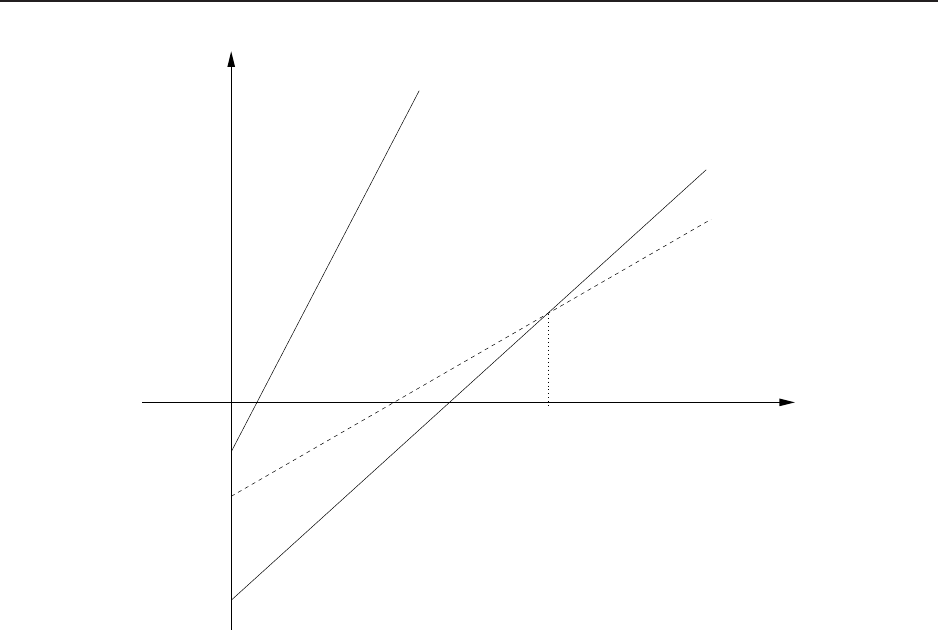
Intermediaries in International Trade
α
αα
d
xd
α
xdxi
α
d
π
i
f
d
f
i
f
x
π
π
π
Figure 1: Profits from domestic sales, indirect and direct exports
lower price, capture a large market share and generate larger profits. The intercept of the domestic
curve is smaller in absolute value than that of exports because the fixed costs that are incurred for
selling on the domestic market (f
d
) are lower than what a fir m must pay to export directly abroad
(f
x
). Moreover, since there is a per unit variable cost of export, the slope of the profit function
for direct exports is flatter than the slope of the profit function for domestic production. These
relationships introduce two productivity cut-offs (α
d
and α
x
), that in turn indicate which ranges
of productivity determine exit, domestic sales only, or dir ect exports.
With the possibility of exporting through intermediaries, firms now have also an additional
option of using the intermediation ‘technology’ to export. By assumption the fix ed costs in the
intermediation technology are lower than the fixed costs of direct exporting and are greater than or
equal to the fixed costs of domestic sales; f
i
is between f
d
and f
x
in Figure 1. Th e degree to which
the intermediation fixed costs are lower than those of direct exporting depends on the combination
of country, industr y and country-variety fixed costs of selling in the foreign market as discussed
further below.
The dotted curve drawn in Figure 1 depicts profits for firms that export indirectly (π
i
) through
an intermediary. If using an intermediary does not raise the variable costs of exporting then all
manufacturers would employ the intermediation technology and export indirectly, π
i
(α) > π
d
(α)
4

Intermediaries in International Trade
∀α. To allow for both direct and indirect exporting, the intermediary exporter faces additional
variable costs. In Akerman (2010), the intermediary sets the export price of each variety as a
standard mark-up over its own marginal cost, where its marginal cost includes both variable trade
costs an d the domestic p urchase price of the variety, which is itself a mark-up over the variable
cost of production. In Ahn et al. (2011), it is assumed that intermediaries face no fixed costs of
exporting but charge a variable cost to transport the good s.
The combination of lower fixed costs an d higher variable costs at intermediaries introduces a
third productivity cut-off, α
i
, which is the zero-profit cutoff for exporting through an intermediary.
3
If α
d
< α
i
< α
x
then there will be an equilibrium with ‘pure’ domestic producers and both direct
and indirect exporting. Firms with productivity levels below α
d
earn negative profits and exit the
industry. Firms with productivity levels between α
d
and α
i
, produce only for the d omestic market.
Firms with productivity between α
i
and α
xd
now can profitably access the foreign market thr ou gh
wholesalers. Finally, firms with productivity levels above α
xd
produce for th e domestic market
and export directly. Note that the group of firms with indirect exports includes some firms with
productivity too low to find it profitable to export directly, α
i
≤ α < α
x
and some firm s of higher
productivity that prefer indir ect to direct exporting, α
x
≤ α < α
xd
.
A firm’s decision regarding the mode of export is determined by variable and fixed trade costs,
which in turn also depends on country and product characteristics. The degree to which fixed costs
are reduced using intermediaries depends on the nature of the fix ed cost, e.g. the combination of
country, industry and country-variety components. We can write the fixed costs of direct exporting
of variety k in industry j to country c as
f
x
= f
c
+ f
j
+ f
kc
where f
c
is a fixed export cost common to all varieties exported to country c, f
j
is a fixed export
cost common to all varieties in industry j regardless of the number of destinations, and f
kc
is a fixed
export cost s pecific to the variety and country. The greater the share of idiosyncratic fix ed costs,
f
kc
, in total fixed costs, f
x
, the lower the possibility for economies of scope and the lower the share
of exports handled by intermediaries. Both country and industry-specific fixed costs allow for the
possibility of indirect exporting. Ex porting intermediaries may arise because they are able to share
the country-specific fixed cost of exporting across many industr ies and varieties and/or they may
exist because they are able to spread industr y -specific fixed costs across varieties and destinations.
Existing theoretical frameworks typically ignore the possibility of industry-specific fixed costs but it
remains an empir ical question as to whether intermediaries are country- or industry-specific relative
to direct exporters.
3
It is possible that no produ cer will choose to export through an intermediary if the increase in variable cost is
sufficiently large.
5

Intermediaries in International Trade
The simple framework provides some clear predictions for th e variation of direct and indirect
trade across countries. To the extent that intermediaries solve only the country-specific fixed costs
of exporting, e.g. each variety exported faces indirect fixed costs f
i
= f
c
/n + f
kc
, where n is the
number of varieties handled by the intermediary, the difference between direct an d indirect fixed
costs will be increasing as country fixed costs rise.
The role of variable trade costs is less clear-cut in these models. A rise in variable trade costs that
affects both direct and intermediary exporters, such as tariffs or tran sportation costs, can increase,
decrease or leave un changed the share of exports handled by intermediaries. In the empirical work
we examine the role of variable trade costs including distance and tariffs in determining the share
of exports handled by intermediaries.
The existing theoretical frameworks emphasize the interaction of producer firm heterogene-
ity and fix ed export costs in th e decision to export directly or indirectly. While these models
are all static models of single-prod uct fir ms, it is relatively easy to envision a dynamic exten-
sion where firms potentially make multiple p roducts and their profitability evolves over time (see
Bernard, Redding and Schott; 2010; Bernard et al.; 2011). In a dynamic environment, variation in
the sunk cost of exporting across firm types would lead to predictable variation in product adding
and product dropping in the export market. Firms facing lower s unk costs would be more likely
to both add and drop products in steady state and in the face of exogenous shocks to profitability.
As intermediary exporters have lower entry costs they should be more likely to churn their export
product mix.
2.1 Related empirical literature
Recent papers by Ahn et al. (2011), Akerman (2010) and Bernard, Jensen, Redding and Schott
(2010b) examine various aspects of intermediaries in exports for China, Sweden and the US, re-
spectively. None of the papers uses exactly the same defi nition of an exporting intermediary so the
results are not directly comparable to each other or those presented below.
4
Bernard, Jensen, Redding and Schott (2010b) docu ment the role of intermediaries in US ex-
ports. They find th at 35 percent of US exporters are wholesalers accounting for 10 percent of
US exports by value. Their work emphasizes the differences in the attributes between exporters
of different types. Among exporting firms, pure wholesalers are much smaller than ‘producer-
consumer’ firms in terms of employment, but only slightly smaller in terms of exports per worker
4
Specifically, Ahn et al. (2011) define an intermediary as a firm with certain Chinese characters in its
name, Akerman (2010) uses the main activity of the firm and includes both wholesalers and retailers and
Bernard, Jensen, Redding and Schott (2010b) distinguish between pure wholesalers, pure retailers and two types
of firms that mix manufacturing with wholesaling and retailing. As discussed below we only consider firms with
wholesaling as their main activity as intermediaries.
6

Intermediaries in International Trade
and domestic sales per worker.
5
Other differences include the types of products exported and the
destinations served, wholesalers are more likely to export food-related sectors and export to lower
income countries.
Akerman (2010) reports slightly more exporting intermediaries than manufacturers and signif-
icant differences between the two types of exporters. Intermediaries are sm aller in terms of total
turnover, much smaller in terms of export value, but export more products and ship to more desti-
nations. Akerman (2010) regresses country-sector intermediary export sh ares on gravity variables
and proxies for country fixed export costs. Intermediary export shares increase in distance and
measures of fixed costs and fall with destination GDP.
In contrast with the other studies, Ahn et al. (2011) find much higher exports per fir m and
unit values for intermediaries than for direct exporters. Interm ediaries are also active in m any
more products than direct exporters. Regressions of p roduct-country intermediary export shares
on country characteristics s how positive relationships for distance, tariffs and a measure of fixed
costs and a negative r elationship with destination GDP.
This paper builds on this growing empirical literature and extends it in a number of directions.
First, it documents the differences between produ cing exporters and intermediary exporters in
terms of their firm characteristics, destination and product m ixes, product churning and export
values and quantities. We then examine export participation and levels by direct and intermediary
exporters across countries and products and their relation to country and product characteristics.
Finally the underlying s ou rces of intermediated trade are shown to cause intermediaries to differ
in terms of their responses to aggregate shocks, both in terms of export value and th e margins of
adjustment.
3 Data
3.1 Trade and Firm data
The analysis of dir ect versus indirect modes of export is based upon two firm-level datasets collected
by the Italian statistical office (ISTAT), namely S tatistiche del Commercio Estero (COE) and
Archivio Statistico Imprese Attive (ASIA).
6
The COE dataset consists of all cross-border trans actions performed by Italian firms and it
covers the period 2000-2007. COE includes the annual value and quantity of export tr an sactions
by the firm for product-country destination pairs.
7
A product is defined as a six digit category in
5
‘Producer- consumer’ firms in Bernard, Jensen, Redding and Schott (2010b) include any firm with no reported
employment in wholesaling or retailing and thus include both manufacturers and other service firms.
6
The database has been made available for work after careful screening to avoid disclosure of individual information.
The data were accessed at the ISTAT facilities in Rome.
7
ISTAT, collects data on exports based on transactions. The European Union sets a common framework of rules
but leaves some flexibility to member states. A detailed description of requirements for data collection on exports in
Italy is provided in the Appendix .
7

Intermediaries in International Trade
the Harmonized System (HS6).
Using the unique identification code of th e firm, we link the firm-level export data to ISTAT’s
archive of active firms, ASIA. In ASIA, firms are classified according to their main activity, as iden-
tified by ISTAT’s standard codes for sectoral classification of business (5-digit ATECO). This infor-
mation allows us to distinguish between four broad categories of firms: manufacturers, wholesalers,
retailers, and a residual group including the remaining sectors.
8
ASIA also contains information on
firms’ operations including the number of employees and total turnover.
9
The combined dataset
used for the analysis is not a sample but rather includes all active firms.
3.2 Country level data
Firm-level trade data are complemented by country characteristics including proxies for market size
and variable and fixed trade costs.
10
For market size we use total GDP from the World Bank World
Development Indicators database. Variable trade costs may be either due to policy barriers, such as
tariffs and non-tariff barriers, or to the cost of moving goods across borders, such as transportation
costs. Following the large gravity literature, transportation costs are proxied by geographic distance
calculated using the great circle formula (Mayer and Zignago; 2005).
As emphasized in the literature on firms and exporting (Roberts and Tybout; 1997; Melitz;
2003; Bernard and Jensen; 2004; Bernard et al.; 2007; Eaton et al.; 2011), firms incur fixed entry
costs in order to enter foreign markets. These fixed costs can be related to the establishment of a
foreign distribution network, difficulties in enforcing contractual agreements, or the uncertainty of
dealing with foreign bureaucracies. We create two measures of country-level fixed costs. To generate
a proxy for the market-specific fixed costs of exporting to a country, we u se information from three
measures from the World Bank Doing Business dataset: number of documents for importing, cost
of importing and time to import (Djankov et al.; 2011). Given the high level of correlation between
these variables, we use the primary factor (Market Costs) derived from pr incipal component analysis
as that factor accounts for most of the variance contained in the original indicators (see Table A1
in Appendix).
Data on the contracting environment are available from a variety of sources, e.g. World Bank,
Heritage Foundation, an d Transparency I nternational. To proxy for institutional quality we use
information from the six variables in the World Bank’s Governance dataset (Kaufman et al.; 2009):
Voice and Accountability, Political Stability and Absence of Violence/Terrorism, Government Ef-
fectiveness, Regulatory Quality, Rule of Law, and Control of Corruption. As these six measures are
highly correlated, we follow Bernard, Jensen, Redding and Schott (2010a) and use the primary fac-
8
In particular, we classify firms in sectors from 151 to 372 as manufacturers, and firms in sectors from 501 to 519
(with the exclusion of 502 which concerns the activity of repair of motor vehicles) as wholesalers. Retailers are firms
in sectors 521 to 527, and Others contains the remaining sectors.
9
Information on total turnover are available only for two years, 2000 & 2003.
10
More details on the country-level variables are available in the Appendix.
8

Intermediaries in International Trade
tor obtained from principal component analysis, Governance, as the proxy for country governance
quality.
11
If fir ms must invest in fixed resources to export to countries w ith weaker contracting
environments, one would expect better Governance to be associated with lower intermediary export
shares.
Finally, in order to account for the effect of policy barriers on the presence of intermediaries and
manufacturers we also consider HS6 product-country im port tariffs, taken from World Integrated
Trade System (WITS).
12
3.3 Product level data
The paper also investigates a set of product and in dustry variables that affect the probability that
a producer exports directly rather than through an intermediary. Goods with high destination-
specific costs of entering a foreign market, or finding a foreign customer, are more likely to be
exported directly. Similarly in dustries with higher entry costs are less likely to be served by direct
exports.
We consider both produ ct characteristics that are related to the specificity of the product
and those more generally related to market structure. A measure of industry contract intensity
develop ed by Nunn (2007) is used to measure the importance of relationship-specific investment in
intermediate inputs across industries. Nunn’s original data, corr esponding to US I-O in dustries,
is concorded to HS6 products.
13
Industries that require more relationship-specific investments are
expected to be less easily served by intermediaries as the product-market compon ent of fixed costs
is relatively large.
In order to account for differentiation within a HS6 pr oduct class we employ the coefficient
of price dispersion.
14
Lower price dispersion is assumed to be associated with m ore homogeneous
products. For homogeneous pr oducts, the product-market component of fixed costs will be lower
and thus it is more likely that the export transactions will be carried out by an intermediary.
We adapt a measure of product-level sunk entry costs developed by Bernard an d Jensen (2007)
to the export market. In steady state, a produ ct with high sunk costs of entry into export markets
should have a low entry rate and a low (and equal) exit rate. During transitions between steady
states, either the entry rate (expanding product) or the exit rate (shrinking product) may be
11
Table A2 in Appendix reports the results of the principal component analysis for the governance measure.
12
WITS contains the TRAINS database on bilateral tariffs at the six-digit level of the Harmonized System (HS)
product classification for about 5,000 products and 200 countries. TRAINS provides information on four different
type of tariffs: Most-Favored National Tariffs (MFN), Preferential Tariffs (PRF), Bound Tariffs (BND) , and the
effectively applied tariffs (AHS). We use the AHS tariff in the empirical analysis. The AHS tariff is the MFN Applied
tariff, unless a preferential tariff exists.
13
See the Data Appendix for a description of the concordance procedure.
14
The coefficient of p rice variation is computed on COE data as the coefficient of variation in the unit values of any
of the HS6 products across all firm-product-country transactions. In th e empirical analysis we use data from 2003,
but the product ranking in terms of price dispersion does not vary much over the years.
9

Intermediaries in International Trade
unusually high. However, the minimum of the two r ates should still correspond to steady-state
entry or exit. We calculate the m inimum of the firm-level export entry and exit rates for each
product, min(entry, exit).
15
A higher level of entry and exit indicates lower sunk costs of exporting
and a lower likelihood that the prod uct will be exported through an intermediary.
4 Manufacturers and Intermediaries
The focus of the present work is to investigate the role of intermediaries in exports. This section
documents the extent of intermediation in Italian exports, highlighting important stylized facts
about intermediaries and showing how they differ from manufacturing firms. Table 1 reports the
total value of exports and the relative share of four broad categories of firms: manufacturers,
wholesalers, retailers, and a residual group including fi rms in all the remaining sectors.
A prepon derance of exports, more than 84 percent of the value, is perform ed directly by man-
ufacturing firms. Manufacturing exporters also represent more than 50 percent of exportin g firms.
However, an increasing share of exp orts is conducted by the 27 percent of exporters that are whole-
salers, rising from 9.9 percent in 2000 to 11.3 percent of Italian exports in 2007. These figur es
are in line with those reported for the US in Bernard, Jensen, Reddin g and Schott (2010b) wh er e
wholesalers are 35 percent of exporting firms and control just over 10 percent of US exports. As
in other countries, retailers are relatively minor players in exporting, accounting for less than one
percent of exports by value. As a result the paper focuses on the role of wholesalers as export
intermediaries and uses the two terms interch an geably.
While intermediaries account for just 11 percent of Italian exports, there is s ubstantial variation
across both countries and products, see Table 2. At the country level, intermediary export shares
range fr om a low of zero to a high of 88 percent. At the bottom of the interquartile range are
countries such as Belgium, Norway, France, New Z ealand and China with intermediary export
shares close to 9 per cent; at the top of the interquartile range, we find Paraguay, Moldova, Malawi
and Albania with wholesale export shares near 23 percent. While the overall share of intermediary
exports is just u nder 11 percent in 2003, across destinations, unweighted intermediary export shares
average 16.6 percent and are higher on average for non -EU countries. This indicates th at wholesalers
are relatively more important in smaller markets and in markets outside the EU.
The share of intermediaries across prod ucts also displays substantial variation, see the second
panel of Table 2. Wholesalers account for 21 percent of the exports for the average product, pointing
to the importance of intermediaries in p roducts with lower total export values. While there exist
15
The entry rate is the number of new exporters of the product between year t and t+s divided by the average
number of exporters in the two years. The exit rate is the number of firms that stop exporting the product between
t and t+s divided by the average numb er of exporters in the two years. The min(entry, exit) in a given product is
computed on COE data for years 2003 and 2007. Considering different years for the computation of the rates does
not significantly affect the results.
10

Intermediaries in International Trade
both products which are sold ab road only through intermediaries, 1.8 percent of 5,125 products,
and others wh er e the share of wholesalers is zero, most products are exported both directly and
indirectly.
Specialization is more common at the product-country level. Of the 244,614 product-country
combinations with positive exports, 48.6 percent involve direct exports only and 10.4 percent are
served exclusively by intermediaries.
16
4.1 Firm characteristics
In their work on US traders, Bernard, Jensen, Redding and Schott (2010b) find not only that
traders differ from domestic firms, but also that substantial h eterogeneity exists between trad-
ing firms of different ‘types’. The results here complement and extend that analysis by comparing
manufacturers and wholesalers along a number of dimensions including size, the number of desti-
nation countries and the number of products exported.
The top left panel of Figure 2 shows the distribution of employment for all wholesale and
manufacturing firms. Th e employment distribution for wholesalers lies far to the left of that for
manufacturers. Overall, intermediaries are much sm aller in terms of number of employees. However,
when we proxy size with total sales (top right panel) the difference between the two distributions
remains but is greatly reduced. The differences between the panels implies that the sales per
employee ratio of wholesalers is much h igher than that of manufacturers.
17
The bottom panels
of Figure 2 show the size distrib utions for wholesale and manufacturing exporters. The relative
ranking of the two distributions is similar to that seen above.
The figures are consistent with the idea that manufacturing firms are performing two activi-
ties, the physical p roduction of the goods and the intermediation of the goods to a downstream
customer, while wholesalers are only engaged in the latter activity. This distinction is important
when attempting to compare the exporting activities of wholesalers and manufacturers as the use
of employment as a proxy for firm size may yield misleading comparisons. A manufacturing firm
with 100 emp loyees will typically have lower sales and exports than a wholesale firm with the same
employment. As a consequence, we use both employment and total sales as proxies for size in the
analysis.
Figure 3 displays the binned relation between log exports and log employm ent, reporting the
(log) number of employees a firm needs, on average, for a certain level of exports.
18
The plot
16
For product-country pairs with a mix of direct and indirect exports the average indirect share is 25.3 percent.
17
We caution that sales per employee is not a good m easure of firm product ivity when comparing firms of d ifferent
types.
18
Binned plots allow for a succinct representation of the relation between two variables and avoid displaying clouds
of thousands of observations. Here data are placed in 20 equally-sized bins according to th eir (log of) export value,
and the x-coordinate d isplays the average of the bin. The y- coordinate is the average (log of) employment within
that bin.
11
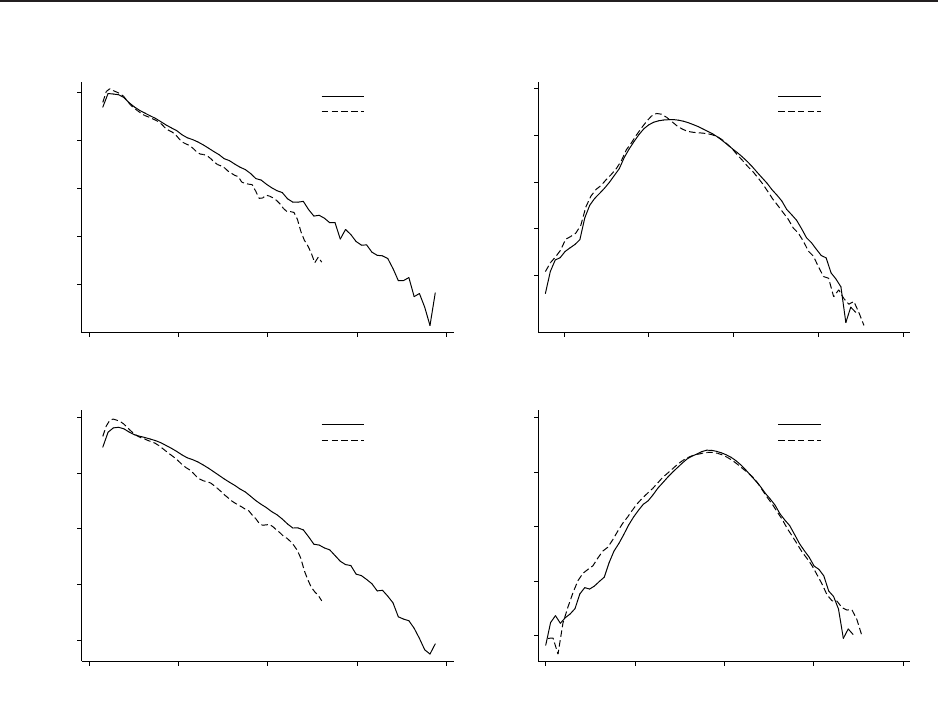
Intermediaries in International Trade
.0001
.001
.01
.1
1
Probability Density
2 4 6 8 10
Log(Number of Employees)
Manufacturers
Wholesalers
Size Distribution
.0001
.001
.01
.1
1
Probability Density
5 10 15 20 25
Log(Sales)
Manufacturers
Wholesalers
Size Distribution
.0001
.001
.01
.1
1
Probability Density
2 4 6 8 10
Log(Number of Employees)
Manufacturers
Wholesalers
Size Distribution for Exporting firms
.0001
.001
.01
.1
1
Probability Density
5 10 15 20 25
Log(Sales)
Manufacturers
Wholesalers
Size Distribution for Exporting firms
Figure 2: Empir ical density of fir m size in 2003 - All fi rms (Top) and Exporters (Bottom). S ize is
proxied by (log of) employment (Left) an d (log of) sales (Right). Densities estimates are obtained
using the Epanenchnikov kernel with the b an dwidth set using the optimal routine described in
Silverman (1986).
confirms that wholesalers require fewer employees to attain any given level of export value.
To quantify the differences between manufacturers and wholesalers, we estimate the following
cross-sectional OLS regression,
ln Y
f
= c + δD
W
f
+ βD
X
f
+ γ(D
W
f
· D
X
f
) + ε
f
(1)
where ln Y
f
denotes the logarithm of either total sales, number of employees, or sales per employee
ratio. D
W
f
is a firm-level dummy variable, one f or wholesaler and zero for manufacturer; D
X
f
is
a dummy indicating if a firm is an exporter; and (D
W
f
∗ D
X
f
) is the interaction between the two
dummies and takes value of one if a firm is a wholesaler exporter and zero otherwise. The results
are presented in Table 3.
As expected, manufacturers are on average larger than wholesalers, 0.111 log points (12 per-
cent) in terms of sales an d 0.533 log points (70 percent) in terms of emp loyment, δ is negative and
12
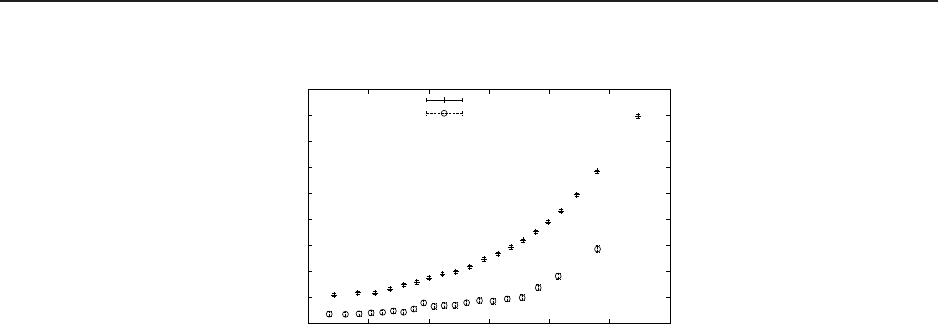
Intermediaries in International Trade
1
1.5
2
2.5
3
3.5
4
4.5
5
5.5
6 8 10 12 14 16 18
ln Employment
ln Exports
Employment per level of exports
Manufacturers
Wholesalers
Figure 3: Relation between (log of) employment and exports, 2003. Observations are placed in 20
equally-sized bin s according to the variable on x-axis. Coordinates of dots display the average of x
and y variables of the data in each b in (see text).
significant in both specifications. In contrast, sales per employee are substantially higher at whole-
salers. We also confirm the now-standard results that manufacturing exporters are dramatically
larger and have higher sales per employee than their domestic counterparts, β is large, positive and
significant.
Perhaps unsurprisingly, we provide the fir st evidence that the selection of firms into exporting
may be working for wholesalers as well. Exportin g wholesale fi rms have total sales 14.8 times
larger than non-exporting wholesalers and employ 2.8 times as many workers, β + γ is positive and
significant. Sales per employee at exportin g intermediaries are 5 times higher than at non-exporters.
Looking at exports in columns 4 and 5 of Table 3, we find that the value of exports at wholesalers
is also much smaller than that of manufacturing exporters but that this difference largely disappears
when considering exports per employee.
The regression results of Table 3 confirm the conclusions from the relative distributional plots in
Figure 2. In particular, the evidence on higher sales per employee, especially at exporters, supports
the idea that wholesalers focus on just the intermediation portion of the activities carried out by
manufacturers.
4.2 Product and Geographic Diversity
The theoretical models discussed in Section 2 generally focus on the role of intermediaries in solv-
ing the fixed cost problem for specific markets. This section prov ides evidence on the presence
of intermediaries in markets and sectors. Figure 4 displays th e relation between geographic and
product diversification of the firm and its size, distinguishing between wholesalers and manufactur-
ers. Geographic diversification is proxied by the number of destination countries (Countries
f
) and
product diversification by the number of products exported (P roducts
f
); size is represented both
13
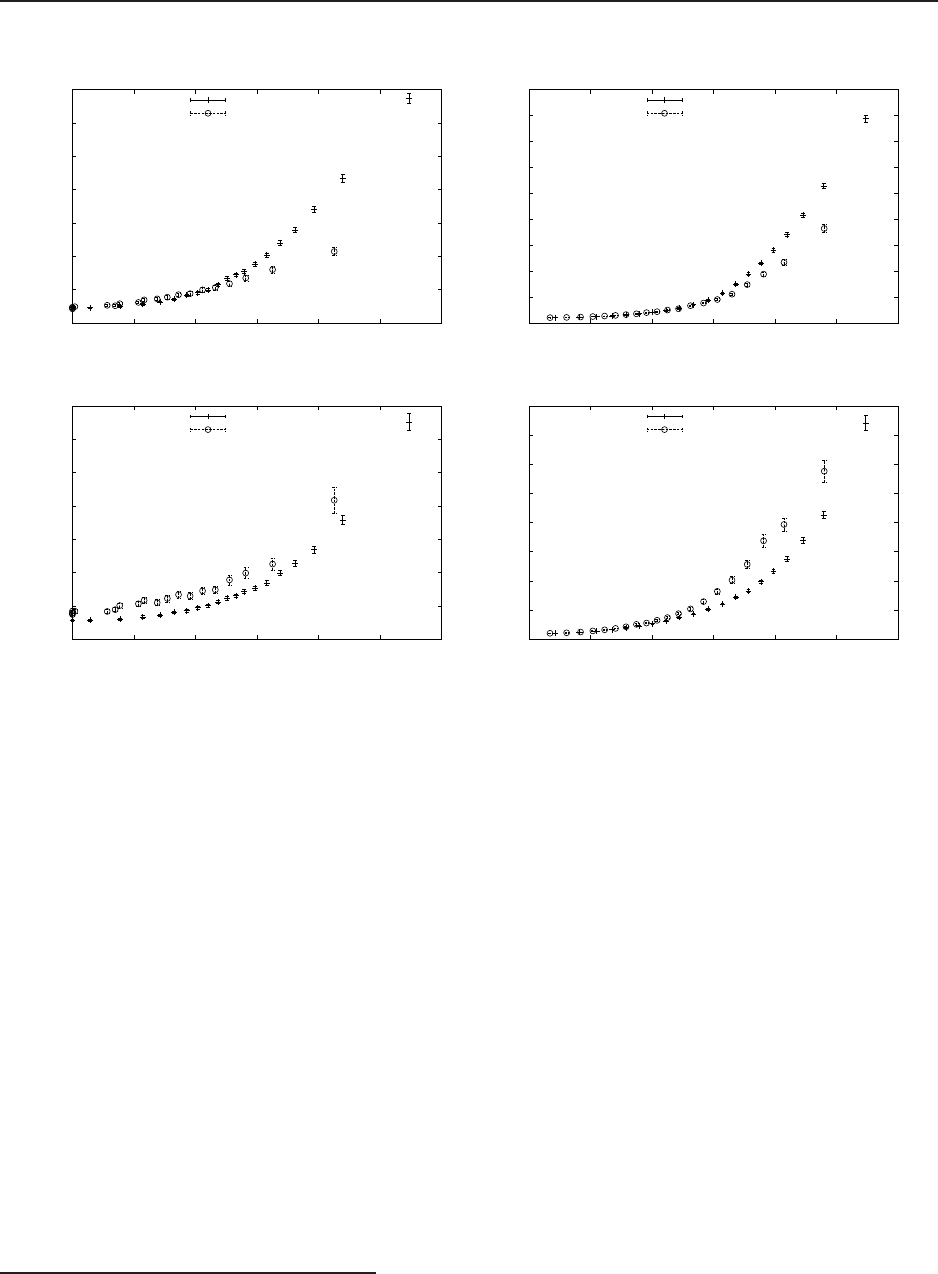
Intermediaries in International Trade
0
5
10
15
20
25
30
35
0 1 2 3 4 5 6
Number of countries
ln Employment
Number of Countries and Employment
Manufacturers
Wholesalers
0
5
10
15
20
25
30
35
40
45
6 8 10 12 14 16 18
Number of countries
ln Exports
Number of Countries and Exports
Manufacturers
Wholesalers
0
5
10
15
20
25
30
35
0 1 2 3 4 5 6
Number of Products
ln Employment
Number of Products and Employment
Manufacturers
Wholesalers
0
5
10
15
20
25
30
35
40
6 8 10 12 14 16 18
Number of products
ln Exports
Number of Products and Exports
Manufacturers
Wholesalers
Figure 4: Top Number of countries and (left) employment and (right) exports, in 2003. Bottom
Number of products and (left) employm ent and (right) exports, in 2003. Observations are placed
in 20 equally-sized bins according to the variable on x-axis. Coordinates of dots display the average
of x and y variables of the data in each bin (see text).
by employment and export value.
The evidence in Figure 4 suggests that the wholesalers’ technology does not convey them an
advantage in terms of geographic diversification, wholesalers export to fewer countries than do
manufacturers at similar levels of employment and exports.
19
On the contrary, when considering
the relation between firm size and product diversification (bottom panel), we find that, at every
size class, wholesalers export more produ cts than manufacturers.
Table 4 reports the results of the regression of the number of products exported and the number
of destination markets (Products and Countries, respectively) on the firm wholesaler dummy, D
W
f
,
and a proxy f or firm size,
Y
f
= c + δD
W
f
+ ln Size
f
+ ε
f
if D
X
f
= 1. (2)
19
Ahn et al. (2011) report that Chinese intermediaries export more products and export to more countries than
direct exporters. However, as noted previously, Chinese intermediary export firms are almost twice as big as direct
exporters in terms of total export value.
14

Intermediaries in International Trade
The firs t row of Column 1 shows that, unconditionally, wholesale exporters export fewer HS6
products. However, including a control for firm size, either log employment or log export value, the
coefficient becomes positive and significant; exporting intermediaries are active in a wider range of
products compared to similarly-sized manufacturers. In contrast, intermediaries serve fewer export
markets even when adjusting for firm size. These resu lts su ggest that intermediaries are indeed
able to spread country-specific fixed costs over a wider range of products.
4.3 Within Product-Country
The availability of product level data allows the comparison of wholesalers and manufacturing
exporters within product-country destinations.
20
Using exports to Extra-EU d estinations for 2003
and considering product-country pairs where both wholesalers and manufacturers are active, we
estimate the following specification,
ln Y
fcp
= c + δD
W
f
+ β ln Sales + d
pc
+ ε
fcp
(3)
where ln Y
fcp
denotes the logarithm of, respectively, th e total value, quantity and unit value of
the firm’s exports in the country-product pair, D
W
f
is the firm wholesaler dummy and d
pc
denotes
country-product fixed effects. The results in the first two columns of Table 5 show that wholesalers
have a substantially lower total value of exports relative to direct exporters within product-country
pairs. The difference in exports across firm types remains even after controlling for firm size,
although the magnitude is reduced. Columns 3-6 report similar regressions for export qu antities
and unit values. The lower exports for wholesalers are driven entirely by lower export quantities;
unit values are not statistically different for direct and intermediary exporters.
4.4 Product Adding and Dropping
The cross-sectional analysis reveals that exporting wholesalers are smaller than manufacturers and
that they export a larger number of products to a sm aller set of destinations. In addition to lower
firm-level trade flows, intermediaries also ship less within a product-country p air. These results
are broadly supportive of a framework emph asizing country-specific fixed costs of exporting. As
discussed earlier, the presence of s unk export costs that vary across firm types also has implications
for export dynamics. Lower sunk costs should result in higher probabilities of both entry into
exporting and exit from exporting. A dynamic extension of the framework presented earlier would
suggest that intermediaries should be more likely to add and drop products from their export
portfolio than direct exporters. This is confirmed by the unconditional drop rates across firms
20
We focus all the remaining empirical work on exports to Extra-EU destinations for several reasons. Most im-
portantly, firm-level exports to the EU are not recorded for all exporters and these criteria have changed over time.
Also, real exchange rate changes within the eurozone countries are driven entirely by changes in relative price levels.
15

Intermediaries in International Trade
types: on average the fraction of exported firm-produ cts outside the EU that is dropped every year
is 50% among all firms, 48% for manufacturers and 53% for wholesalers.
Following Bernard, R edding and Schott (2010), we analyze export product switching between
t and t + 1 using those years for which we have information on firms’ total turnover, 2000-2001 and
2003-2004. We estimate a linear probability model of product dropp ing for firms that export in
year t and t + 1 of the form,
Drop
fpt
= c + δD
W
ft
+ β
1
ln Sales
ft
+ β
2
Deviation
fpt
+ β
3
ln P roducts
ft
+ d
p
+ d
t
+ ε
fpt
(4)
where Drop
fpt
takes value 1 if the product is exported by the firm f in year t and not exported in
year t +1 an d equal zero if the produ ct is exported in both years. D
W
ft
is the firm wholesale dummy
and is the variable of interest. To control for firm attributes associated with product switching, we
include firm size, ln Sales
ft
, the relative importance of the firm in the exports of the product given
by the log difference between the firm’s exports in product p and average firm exports in product p ,
Deviation
fpt
, and the number of products exported by the firm in year t, ln P roducts
ft
. Product
and year fixed effects, d
p
and d
t
respectively, are also included.
Table 6 reports the results of the estimation of the firm-pr oduct droppin g specification equa-
tion 4 for Extra-EU countries. Wholesaler exporters are much more likely to drop a pr oduct than
manufacturer exporters, 6.9 percentage points or 14.4 percent. This differential persists even con-
trolling for firm size, the number of exported products and the relative importance of the firm in
the product, although the magnitude of the coefficients is reduced.
If wholesalers have lower sunk costs per product, then they s hould also be more likely to add
products.
21
We examine the probability that a current exporter adds a product to its export
portfolio between years t and t + 1 in the specification,
Add
ft
= c + δD
W
ft
+ β
1
ln Sales
ft
+ β
2
ln P roducts
ft
+ d
ind
+ d
t
+ ε
ft
(5)
where Add
ft
takes value 1 if the firm adds an export product and zero otherwise. D
W
ft
, ln Sales
ft
,
and ln P roducts
ft
are defined as above. Add itional controls include year fixed effects, d
t
, and
industry-mix fixed effects, d
ind
that controls f or firm s with the same mix of industries at the HS2
level.
22
Results of Table 7 show that intermediaries are more likely to add a product th an manufacturers.
This finding is robust to controlling for firm size and number of exported products, and the effect
is more pronounced when comparing wholesalers and manufacturers among single product firms.
21
On average the fraction of firms that add at least one export product outside the EU every year is 79%: 79% for
manufacturers and 80% for wholesalers. Among single product (multiple products) firms the ratio is 65% (83%) for
all firms, 62% (83%) for manufacturers and 69% (83%) for wholesalers. On average the fraction of firms that drop
at least one export p roduct outside t he EU every year is 80%: 80% for manufacturers and 79% for wholesalers.
22
While the dropping regression was estimated at the firm-product level, the adding specification is at th e firm-level.
16
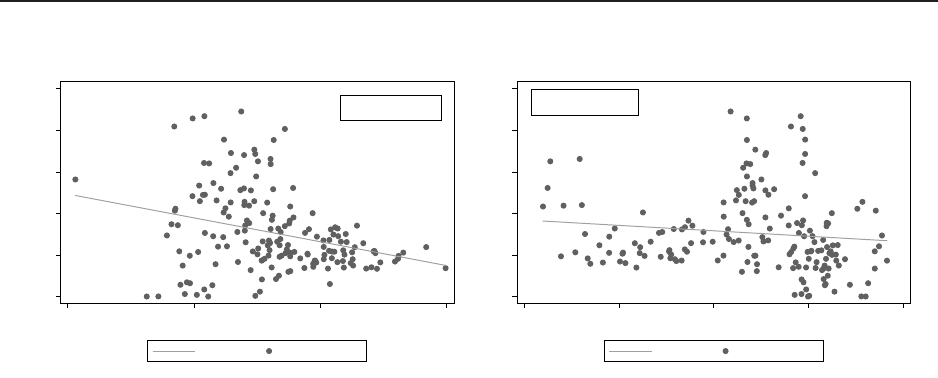
Intermediaries in International Trade
b=−0.011 (0.003)
0 .1 .2 .3 .4 .5
Intermediary Export Share
15 20 25 30
Log (GDP)
Linear Fit Observed Value
Wholesale Export Share & Market Size
b=−0.0013 (0.008)
0 .1 .2 .3 .4 .5
Intermediary Export Share
6 7 8 9 10
Log (Distance)
Linear Fit Observed Value
Wholesale Export Share & Market Distance
Figure 5: Wholesale export share and gravity variables, 2003. Figures report the relationship be-
tween wholesale export share and gravity variables: (Left) Real GDP; (Right) Geographic distance.
Each panel reports the coefficient, b, of a country-level univariate regression for intermediary export
share. Robust standard error is shown in parenthesis.
The results on both export product dropping and export produ ct adding suggest that interme-
diary exporters face lower sunk costs of participation in the export market. These findings suggest
that shocks such as changes in tariffs or exchange rates may have differential effects on wholesalers
and manufacturers even within the same country-product pair. We return to examine the effects
of exchange rate changes across firm types in the final s ection of the paper.
5 Exports by Intermediaries
The previous sections have shown that exporting wholesalers differ from manufacturing exporters
in terms of size, geographic coverage, product portfolio and entry and exit. This section focuses on
differences in the role of wholesalers across countries and products.
5.1 Intermediary E xport Share
We start by exploring the relationship between the intermediary export sh are by destination market
and a set of relevant country variables (Figures 5-6). The correlation of intermediary export shares
by country with market size and distance is displayed in the two panels of Figure 5. Wh olesale
export share is declining in log GDP, smaller markets have greater intermediary export shares,
consistent with the idea that in s maller destination markets, fixed entry costs have to be spread
over fewer units. In contrast, there is no statistically significant relationship between distance, a
common proxy for variable trade costs, and the intermediary export share.
Country-specific fixed costs of trade are generally expected to be positively related to inter-
17
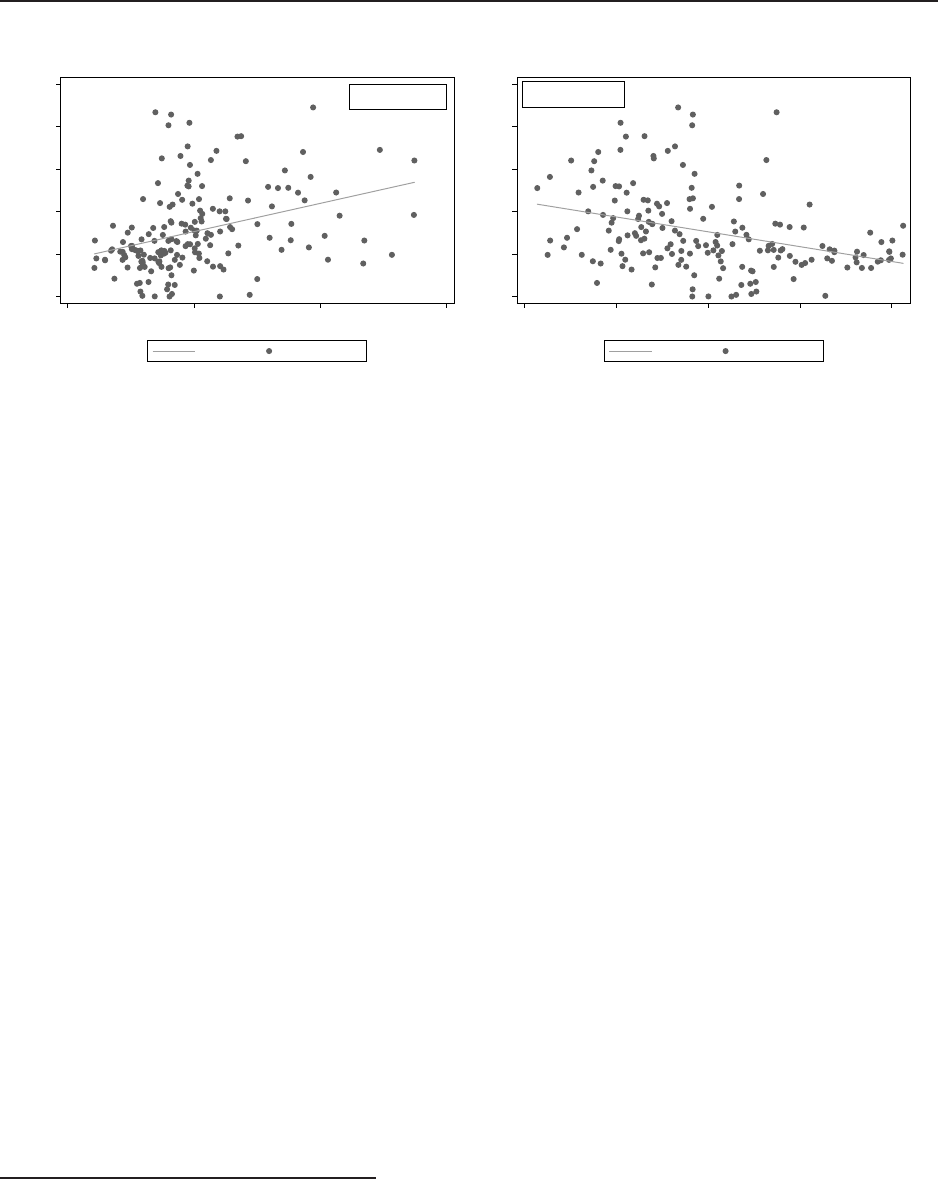
Intermediaries in International Trade
b=0.033 (0.007)
0 .1 .2 .3 .4 .5
Wholesale Export Share
−2 0 2 4
ln (Market Costs)
Linear Fit Observed Value
Wholesale Export Share & Market Costs
b=−0.035 (0.005)
0 .1 .2 .3 .4 .5
Intermediary Export Share
−2 −1 0 1 2
Governance Indicator
Linear Fit Observed Value
Wholesale Export Share & Governance Indicator
Figure 6: Wholesale export share and country-level fixed costs, 2003. Figures report the relationship
between wholesale export share and the two proxies for fixed market entry costs: (Left) Market Size;
(Right) Governance indicator. Each panel reports the coefficient, b, of a country-level univariate
regression for intermediary export share. Robust standard error is shown in parenthesis.
mediary tr ad e shares.
23
The plot at the left of Figure 6 displays the relationship between the
percentage of export value that goes through intermediaries and the Market Costs variable. As
found by Ahn et al. (2011) and Akerman (2010 ), this measure of market access costs is positively
and significantly related to intermediary trade shares.
The right panel of Figure 6 plots the intermediaries export share against country Governance.
As expected, the quality of country governance is negatively and significantly related to intermedi-
aries export share. This evidence supports the idea that as country-level fixed costs increase, more
firms use wholesalers for exporting.
Finally, we investigate the link between the HS6 p roduct characteristics and intermediary export
shares. While the theoretical models remain largely silent on th is aspect, product characteristics
would be expected to play a r ole in explaining the type of fi rm handling the exports.
24
If goods w ith
higher relation-specificity have relatively larger product-country fixed costs of exporting, the share
of direct exports is likely to be greater. Transactions involving complex goods, whose production
process is intensive in the use of highly specialized and customized inputs, may require specific
knowledge and tasks because of the effort associated with the identification of potential customers,
more detailed contracts, post-sale service, etc. For those goods, the product-market component of
fixed costs is relatively large and such goods are more likely to be exported directly by manufacturing
23
Higher country-level fixed costs of exporting and weaker governance are associated with smaller total levels of
exports (Lawless; 2010; Djankov et al.; 2011), here we consider their relationship to the comp osition of exports by
firm type.
24
While not discussed explicitly in his paper, Akerman (2010) models the p rice of exports by intermediaries as
a double mark-up over tariff-adjusted marginal cost. Increases in the d emand elasticity reduce the mark-ups and
narrow the difference between the export p rices of intermediaries and th ose of direct exporters and increase the share
of exports by intermediaries.
18
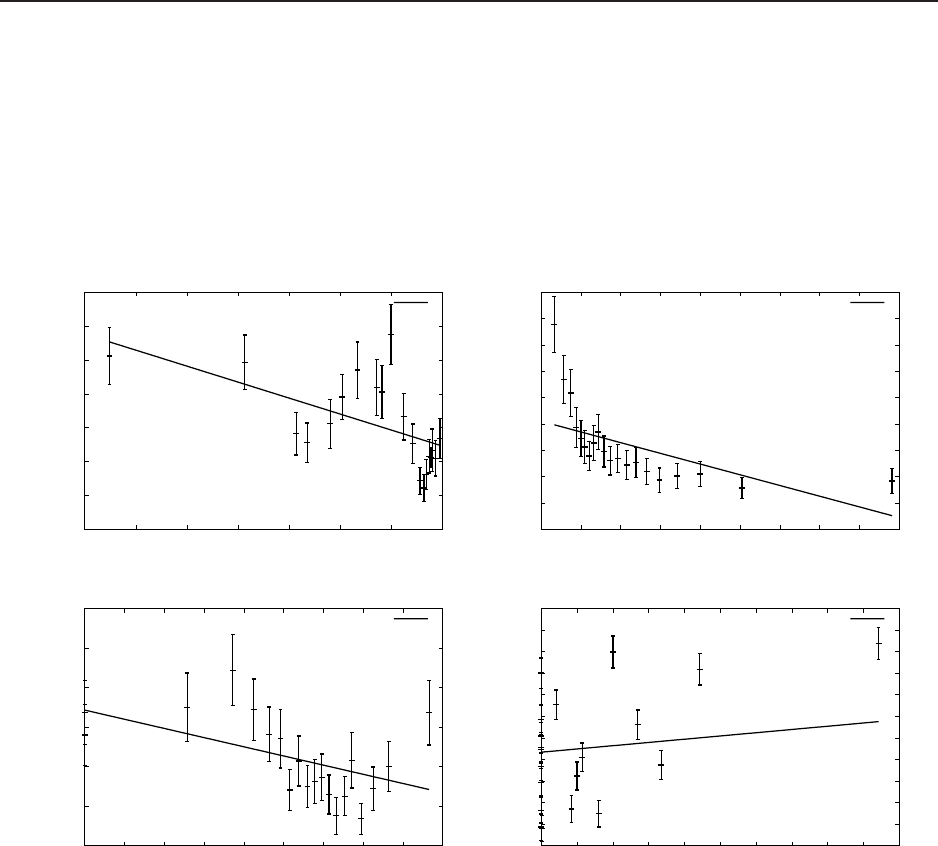
Intermediaries in International Trade
0.05
0.1
0.15
0.2
0.25
0.3
0.35
0.4
0.3 0.4 0.5 0.6 0.7 0.8 0.9 1
Wholesale Export Share
Relation Specificity
Wholesale Export Share & Relation Specificity
b=-0.236 (0.023)
0.05
0.1
0.15
0.2
0.25
0.3
0.35
0.4
0.45
0.5
0 1 2 3 4 5 6 7 8 9
Wholesale Export Share
Price dispersion
Wholesale Export Share & Coeff. of Variation
b=-0.020 (0.001)
0.1
0.15
0.2
0.25
0.3
0.35
0.4
0 0.1 0.2 0.3 0.4 0.5 0.6 0.7 0.8 0.9
Wholesale Export Share
Entry/Exit rate
Wholesale Export Share & min(entry,exit)
b=-0.116 (0.017)
0.15
0.16
0.17
0.18
0.19
0.2
0.21
0.22
0.23
0.24
0.25
0.26
0 5 10 15 20 25 30 35 40 45 50
Wholesale Export Share
Tariff
Wholesale Export Share & (all product-country) tariffs
b=0.0003 (2.959e-05)
Figure 7: Wholesale export share an d Product/Country-Product characteristics, 2003. Figures
display the relationship between wholesale export share and the following characteristics: (Top
Left) Relation Specificity; (Top Right) Coefficient of Variation of the unit values for each prod uct;
(Bottom Right) min(entry, exit) in the export market for a given product; (Bottom Left) Country-
Product export tariffs. Observations are placed in 20 equally-sized bins. Coordinates of dots d isplay
the average of tariffs and intermediary export share of the data in each bin. Each panel reports
the coefficient, b, of a product-level univariate regression for intermediary export share. Robust
standard error is shown in parenthesis.
19

Intermediaries in International Trade
firms. On the contrary, the indirect mode of export would prevail if the traded good does n ot
require a relation-specific investment, as for commoditized products. T his prediction is in line
with the hypothesis put f orward by Peng and Ilinitch (2001) “the higher the commodity content of
the product, th e more likely that export intermediaries will be selected by manufacturers”. This
is confirmed by Figure 7 (top left) which shows a negative and s ignificant relationship between
intermediary export share an d the measure of relation specificity. Note that, given the very large
number of ob servations, data are binned in all plots of Figure 7, although the regression coefficients
are based on all the data.
The relation between p roduct price dispersion, as pr oxied by the coefficient of variation of
export unit values, and intermediary share is negative and significant, Figure 7 top right. This is
the expected relationship if lower price dispersion is associated with more homogeneous products
which are more likely to be hand led by intermediaries.
The plot at th e bottom left of Figure 7 displays the r elation between min(entry, exit) rate in
a product and intermediary export sh are. The negative and s ignificant slope suggests that easier
export entry and exit is associated with a lower export share f or wholesalers. Products that have
higher sunk costs of entry (low rates of entry/exit) are more likely to be handled by intermediaries.
Finally we consider the incidence of tariffs on the presence of intermediaries in product-country
pairs. The bottom right of Figure 7 shows the relation between product-country tariff and in-
termediary export share. There is a small, positive relation between product-country tariffs and
intermediary share.
The overall message of these figures is consistent with the idea that there is a systematic
relationship between the share of exports m an aged by wholesalers and both country and product
characteristics.
5.2 Selection into different modes of export
The previous section has investigated the univariate correlations of country and product charac-
teristics with the intermediary export s hare. This s ection and the next explore the relationship
between country and product characteristics and export participation and levels by wholesalers and
manufacturers.
Recent work on the importance of distance and GDP on the level of exports has emphasized
the role of firm selection, e.g. Helpman et al. (2008). The empirical literature on intermediation
has not considered selection effects. The iss ue is m ore difficult than the standard export problem in
that there are potentially different selection criteria for intermediary and d irect exporters. Ideally,
we would s ee the characteristics of the producing firm and th e choice of whether or not to export
and by what method. However, the trade data limits us to observing whether or not a product is
exported by wholesalers alone, manufacturers alone or by both methods. We pursue an admittedly
20

Intermediaries in International Trade
imperfect solution by first examining the relationship between pr oduct and country attributes and
the type of exporter and then examinin g how the value of exports varies between wholesalers and
manufacturers.
The theoretical framework outlined in Section 2 gives some guidance to the selection problem.
Four mutually exclusive situations might arise as fixed costs of exporting increase. If such costs are
zero, or very low, m anufacturers will choose to export directly. For higher fixed costs, some firms
will find it profitable to export in directly while some, more productive firms still export directly.
With suffi ciently high fix ed costs, a third outcome is possible where all firms go through wholesalers.
At the extreme, prohibitive fixed costs will result in no exports in th e product-country pair.
We rank the categories in order of increasing difficulty in entering the export market (direct
only, both dir ect and indirect, indirect only) and estimate an ordered probit model to investigate
the effects of country and product variables in determining the probability of being in one of the
three states,
Category
pc
= c + β
1
C
c
+ β
2
P
p
+ β
3
τ
pc
+ ε
pc
(6)
where Category
pc
accounts for the possible three ou tcomes described above, C
c
and P
p
are country
and prod uct variables, and τ
pc
is tariff to a particular country-product destination. Results are
reported in the first column of Table 8. While most of the coefficients have the predicted sign and
are significant, the proportional odds approach is easily rejected as indicated by the χ
2
test.
Given the rejection of the ordering of outcomes, column s 2 and 3 of Table 8 report the results
for a multinomial logit specification, where the baseline category is exports by manufacturers only.
Country GDP is positively associated with both type of firms serving the market but is negatively
associated with the likelihood of the market being served by wholesalers alone. Geographical
distance lowers the prob ab ility of both groups exporting relative to only manufacturing; comparing
only wholesalers to only manufacturing we find the same negative sign with a lower magnitude.
The measures of fixed costs of exports, Market Costs and Governance, behave as predicted by
the theory. Market Costs show the expected positive sign; higher market costs increase the probabil-
ity of both categories of firms exporting with r espect to the baseline category, only manufacturing,
and also increase the probability that wholesalers are the only exporters in the pr oduct-country
pair. Better country governance reduces the likelihood that the market will be served by both
wholesalers and manufacturers. Similarly, the Governance measure is negatively associated with
only wholesaling.
Looking at the product characteristics, we find the expected sign on the min(entry, exit) p roxy
for product-level sunk costs. Lower sunk costs reduce the probability of both categories exporting
relative to the baseline category and the same relation holds also for wholesalers versus manufac-
turers only. The effects of product price disper s ion and relation specificity are less clear and depend
21

Intermediaries in International Trade
on the groups being compared.
5.3 Product-country exports
This section investigates the effects of country and product characteristics on the level of exports
of manufacturers and wholesalers for product-country pairs. Columns 1 to 3 of Table 9 report
regression results with the log of country-product exports by exporter type, ln X
i
cp
, as dependent
variable and country and product characteristics, C
c
and P
p
, as explanatory variables, together
with a full set of interactions w ith the wholesaler dummy, D
W
,
ln X
i
cp
= c + δD
W
+ β
1
C
c
+ γ
1
C
c
∗ D
W
+ β
2
P
p
+ γ
2
P
p
∗ D
W
+ β
3
τ
pc
+ γ
3
τ
pc
∗ D
W
+ d
j
+ ε
cp
. (7)
Columns 1 and 2 add country and product fixed effects, respectively, while column 3 includes all
the available product and country characteristics.
25
Results on the country characteristics in column s 1 and 3 suggest that the level of exports of
both manufacturers and wholesalers exports is positively correlated with GDP, however the effects
are significantly lower for wholesalers. In contrast to Ahn et al. (2011), geographical distance affects
negatively the value of trade equally for both types of firms.
26
The results on Market Costs and Governance are in line with the theoretical predictions. Inter-
mediaries’ exports increase with market costs, suggesting that wholesalers are better able to spread
fixed costs across produ cts. The country governance indicator yields a similar pattern of results:
better governance is associated with higher exports from manufacturers but that effect is greatly
reduced or disappears entirely for wholesalers.
Columns 2 an d 3 of Table 9 report the r esults on the p roduct characteristics. We focus on
the sign and significance of the interaction term s with the wholesaler dum my. Wholesalers export
relatively less in products w ith lower sun k entry costs, i.e. greater min(entry, exit), higher price
dispers ion, and higher relationship specificity. All th ese coefficients have the expected signs and
point to product characteristics playing an important part in the endogenous choice of firms to
export directly or through an intermediary.
Finally, we include tariffs in column 3. As expected, the coefficient of tariffs exhibits a negative
sign; firms export less in country-product pairs with higher tariffs. The wholesaler interaction is
positive but not significant.
This section has examined th e role of country and product characteristics in the choice of
the mode of export and the magnitude of country-product exports. Results confir m the findings
of p revious studies th at country-specific fixed export costs are correlated with the use of export
25
In Column 3 we cluster both on countries and products using cluster2 packages for Stata (Petersen; 2009).
26
The specification of Ahn et al. (2011) is slightly different as they include a smaller set of covariates and do not
include the interacted wholesale dummy.
22

Intermediaries in International Trade
intermediaries. We further show that the quality of the more general contracting environment is
related to the choice of mo de of export. Exports through an intermediary are more likely wh en the
quality of the general contracting environment of the country is weak.
We also show that the characteristics of the product play a role in determining the choice of
export mode. Lower contract intensity, greater product homogeneity, and higher produ ct-level sunk
costs of exporting are associated with a greater reliance on intermediaries in exporting.
6 Intermediaries and exogenous shocks
We have documented the variation in the share of indirect exports across countries and products.
The results support the id ea that export intermediaries arise in large p art because of the presence
of s ignificant fixed export costs at the country and product level. In addition, product adding an d
product dropping in the export market are greater for wholesale exporters than for manufacturers.
Taken together this evidence suggests that a common sh ock to profits across destinations, e.g.
a common tariff cut, may have different effects both across types of exporting firms and in the
aggregate across countries due to variation in the composition of exporters.
This section examines whether intermediaries and manufacturers respon d differently to exoge-
nous cur rency shocks. Using annual fluctuations in bilateral real exchange rates as measures of
exogenous changes in export profitability, we investigate th e effects on firms’ export behavior. We
consider the impact of exchange rate changes on fir m exports to country c, as well as on the number
of exported products and the average value of exports to that destination. Following Bernard et al.
(2007) a firm’s total exports to a destination can be decomposed into extensive and intensive
margins,
ln X
fc
= ln P rod
fc
+ ln avgX
fc
(8)
where ln X
fc
is th e log of total exports by firm f to country c, P rod
fc
is th e number of distinct
HS6 products exported by firm f to country c, and avgX
fc
is th e average exports per exporting
firm f to country c. We regress the annual log change from 2000 to 2007 of firm total exports to
country c and the annual changes of the two components on a dummy for wholesaler (D
W
ft
), the
change in the log of the real bilateral exchange rate of the Italian currency (∆ln RER
ct
) and their
interaction
∆ln X
fct
= c
1
+ δ
1
D
W
ft
+ β
1
∆ln RER
ct
+ γ
1
∆ln RER
ct
∗ D
W
ft
+ d
j
+ ε
1
fct
(9)
∆ln P rod
fct
= c
2
+ δ
2
D
W
ft
+ β
2
∆ln RER
ct
+ γ
2
∆ln RER
ct
∗ D
W
ft
+ d
j
+ ε
2
fct
(10)
∆ln avgX
fct
= c
3
+ δ
3
D
W
ft
+ β
3
∆ln RER
ct
+ γ
3
∆ln RER
ct
∗ D
W
ft
+ d
j
+ ε
3
fct
(11)
23

Intermediaries in International Trade
where d
j
indicates a set of fi x ed effects. Using data from the International Financial Statistics
database (IMF, 2010), we defi ne the RER
ct
index for each year:
RER
ct
= ER
ct
CP I
t
CP I
ct
where ER
ct
is the nominal Italian exchange rate expressed as the number of foreign currency
units per home currency unit and
CP I
t
CP I
ct
is the ratio of the domestic consum er price level and
the consumer price index abroad.
27
An upward (downward) movement therefore represents an
appreciation (depreciation) of the domestic currency.
Table 10 reports results from estimating equations 9-11. Since real exchange rate variations
inside the Eurozone are related only to price levels changes and given the relevant role of wholesalers
in Extra-EU destinations, we include in the regressions only countries ou tside the E U.
The first two columns of Tab le 10 present the r esults for export value, including country and year
fixed effects (column 1) and country and firm fixed effects (column 2). Exchange rate movements
have the expected effects on firm exports to country c: an appreciation of the euro currency is
associated with a decrease in firm exports. However, the interaction of wholesaler type and the real
exchange rate is positive and signifi cant in both columns; firm exports fall less (3.7-8.4 percent) for
intermediaries than for manufacturers when the Italian currency appreciates.
Looking at columns 3-6 we observe that, for both manufacturing and wholesale firms, the fall in
exports in respon se to an appreciation of the domestic currency is driven both by a decrease in the
number of products exported and by a decline in the fir m’s average exports per country. However,
for w holesalers, the adju stment on the extensive margin of the number of products is greater,
while the response of aver age exports is more muted. These results would appear to confirm that
wholesale exporters face lower fixed costs and are thus able to adjust more easily along the extensive
margin than direct exporters.
We next explore the sensitivity of the firm’s response within a country-product pair to annual
exchange rate movements by considering export value, qu ality and unit value. The estimation
equation is
∆ln Y
fpct
= c
1
+ δD
W
ft
+ β
1
∆ln RER
ct
+ γ∆ln RER
ct
∗ D
W
ft
+ d
j
+ ε
fpct
(12)
where ln Y
fpct
is the log of firm-level product-country export value, quantity or unit value. Columns
1, 3 and 5 of Table 11 report results with country, product and year fixed effects, while in columns
2, 4 and 6 replace product dummies with firm-product fixed effects. As before, exports fall as
the Italian currency appreciates but the effect for wholesalers is 15-30 percent sm aller. For direct
exporters the ad justment to a stronger home cur rency is primarily due to reductions in export
27
Details on the exchange rate variables are available in the Appendix.
24

Intermediaries in International Trade
quantities (90 percent) rather than in unit value (10 percent). For wholesalers, the overall adjust-
ment is smaller due to a much smaller quantity response. Wholesalers drop their unit values more
as the currency rises, pass-through is lower, and quantities fall less.
The literature on intermediaries in trade largely has focused on the underlying choice of firms
to export directly or indirectly and in particular on the role of fixed export costs. This section has
shown that these choices give rise to different respon ses to common external shock s to profitability.
Wholesalers are less responsive to exch an ge rate changes precisely because they are better able to
adjust along the extensive margin.
6.1 Aggregate Exports
The firm-level results presented above suggest that the en dogenous choice of direct or in direct
exporting by producing firms should matter for the response of aggregate, country-level export
volumes to exogenous shocks s uch as changes in the exchange rate. Destinations with high wholesale
export shares should show smaller responses of exports in response to exchange rate changes than
countries with low wholesale export shares.
In Table 12 we consider a simple specification of the form
∆ln Y
ct
= c
1
+ δD
W
c
+ β
1
∆ln RER
ct
+ γ∆ln RER
ct
∗ D
W
c
+ d
j
+ ε
ct
(13)
where ln Y
ct
is the log of country exports and D
W
c
is a dummy that equals one if the country-level
share of wholesale exports is greater than the median (mean), and the exchange rate is defined as
before. Columns 1 and 3 report r esults with year fixed effects, while columns 2 and 4 include both
year and country fixed effects.
In every case, the results strongly confirm the importance of the mode of export in sh ap ing the
aggregate responses to changes in the real exchange rate. The exchange rate export elasticity for
countries with low wholesale shares is negative and significant, ranging from -0.232 to -0.499 across
the specifications. In contrast, countries with wholesale export s hares above the mean or median
have elasticities that are insignificantly different from zero.
7 Conclusions
The present paper examines the role of intermediaries in exporting, the factors that lead firms to
export indirectly, and the consequences of intermediary exporters on tr ad e value and the margins
of adjustment to external shocks. Using Italian firm-level trade data, we investigate the impor-
tance of wholesalers in exports across destinations and products an d examine how they differ from
manufacturing fi rms that export dir ectly. Intermediary exporters are smaller, ship more products
and reach fewer countries than direct exporters.
25

Intermediaries in International Trade
We confirm the findings of previous research that w holesalers are more likely to export to
countries with high fixed export costs and to smaller m arkets. However, exporting by wholesalers
is also more common in destinations with weak contracting environments and in products that
are more homogeneous, have higher sun k entry costs and have lower relationship specificity. The
ability of intermediaries to effectively lower destination and product fixed costs means that they
are to churn their product mix more often and adjust along the extensive margin.
The differences in fixed costs across destinations and products h ave important implications
for firm-level and aggregate responses to exogenous changes in profitability such as exchange rates.
Wholesalers are more likely to adju st their product mix in r esponse to an exchange rate change and
their total exports adjust less. Given the big difference in the share of intermediated exports across
countries and products, these firm-level results suggest that there are potentially large differences
in how aggregate exports will respond to changes in the value of the domestic cur rency that are
linked to the type of the exporting firm. We find significantly lower r esponses of aggregate exports
to changes in the exchan ge rate for destinations served primarily by wholesale exporters.
26
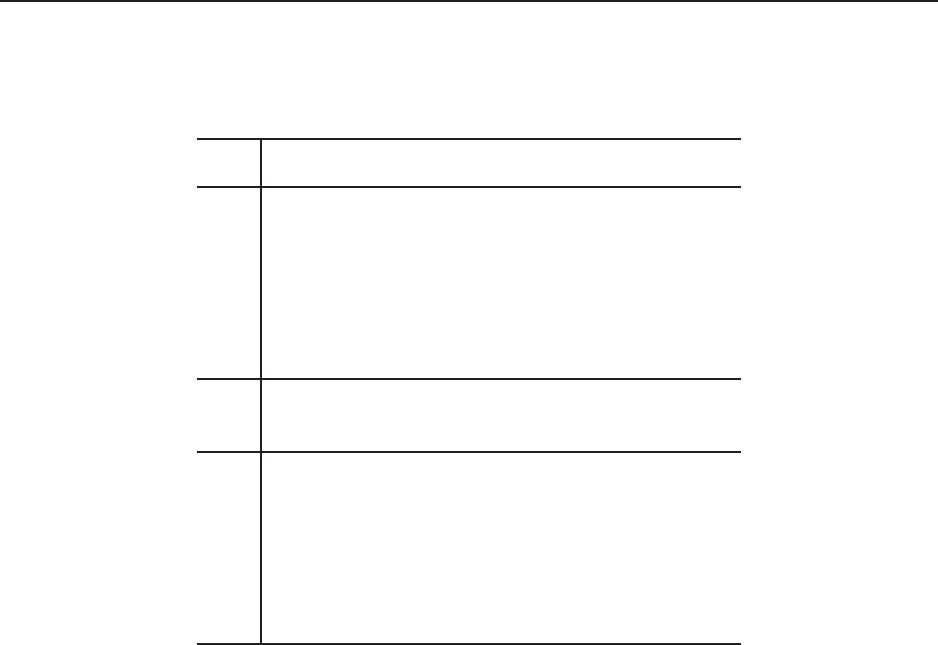
Intermediaries in International Trade
Table 1: E x ports and Number of exporting firms: share by type of firms, 2000-2007
Year Total Exports Manuf Whol Retail Others
(billion) Share (%)
2000 246.79 85.09 9.85 0.74 4.32
2001 258.99 86.49 9.88 0.86 2.76
2002
260.75 84.75 10.93 0.83 3.49
2003 254.91 85.52 10.71 0.86 2.91
2004
274.38 85.65 10.5 0.82 3.91
2005 286.56 85.5 10.75 0.85 4.91
2006 319.01 84.95 11.32 0.85 5.91
2007
350.57 85 11.27 0.84 6.91
Year Exporters Manuf Whol Retail Others
(N. of firms) Share (%)
2000 137347 57.3 26.43 7.67 8.6
2001 141520 56.46 27.01 7.95 8.58
2002 145473 55.64 27.06 8.14 9.16
2003
143421 55.57 27.41 7.72 9.3
2004 139598 55.34 27.61 7.46 10.3
2005 133473 54.96 27.48 7.3 11.3
2006
139360 53.7 28.07 7.31 12.3
2007 128472 54.77 27.91 6.88 13.3
Note: Table reports the share of exports and the share of exporters by type of firms (Manufacturers, Wholesalers,
Retailers and Others).
27

Intermediaries in International Trade
Table 2: Descriptive statistics of Wholesale export share at Country, P roduct and Country-product
level, 2003
Obs Zeros Ones Mean Median
All sample 228 8 0 .166 .133
Country Intra-EU 14 0 0 .118 .109
Extra-EU 214 8 0 .170 .137
All Sample 5125 226 95 .211 .098
Product Intra-EU 5009 579 156 .204 .056
Extra-EU 5011 332 129 .220 .116
All Sample 244614 118891 25506 .208 .001
Country-Prod I ntra-EU 51274 17717 3559 .187 .014
Extra-EU 193340 101174 21907 .213 0
Table 3: Export premia, 2003
ln Sales
f
ln Employment
f
ln Sales/Empl.
f
ln Exports
f
ln Exports/Empl.
f
(1) (2) (3) (4) (5)
D
W
f
-0.111*** -0.533*** 0.433*** -1.047*** -0.025
(0.004) (0.002) (0.003) (0.016) (0.015)
D
X
f
2.775*** 1.533*** 1.229***
(0.007) (0.005) (0.004)
D
W
f
· D
X
f
-0.081*** -0.489*** 0.388***
(0.012) (0.008) (0.008)
R-squared 0.22 0.29 0.14 0.03 0.001
Observations 985719 1022424 985710 118994 118994
Notes: Table reports OLS regression of noted characteristic on dummy for wholesaler (D
W
f
), dummy for exporter
(D
X
f
), and their interaction (D
W
f
· D
X
f
). Robust standard errors are reported below coefficients. Asterisks denote
significance levels (***: p <1%; **: p<% 5%; *: p<10%). Data are for 2003.
28

Intermediaries in International Trade
Table 4: E x port premia: Number of Countries and Number of Products, 2003
Products
f
Products
f
Products
f
Countries
f
Countries
f
Countries
f
D
W
f
-1.269*** 3.005*** 1.668*** -4.562*** -0.158*** -1.630***
(0.093) (0.118) (0.088) (0.058) (0.053) (0.043)
ln Employment
f
4.180*** 4.307***
(0.070) (0.036)
ln Exports
f
2.805*** 2.801***
(0.027) (0.015)
R-squared 0.001 0.13 0.25 0.03 0.27 0.45
Observations 118994 118994 118994 118994 118994 118994
Notes: Table reports OLS estimates of the number of HS6 products exported (Products
f
) and the number of desti-
nation countries (Countries
f
) on a dummy for wholesaler (D
W
f
). The regression sample is exporting fi rms. Robust
standard errors are reported below coefficients. Asterisks denote significance levels (***: p < 1%;**: p <5%; *: p<%
10%). Data are for 2003.
Table 5: Firm’s exports, quantity and unit value by product an d country by different type of firms,
2003 - Extra-EU
ln Exports
f cp
ln Exports
f cp
ln Quantity
f cp
ln Quantity
f cp
ln UnitValue
f cp
ln UnitValue
f cp
(1) (2) (3) (4) (5) (6)
D
W
f
-0.307*** -0.113*** -0.314*** -0.115*** 0.007 0.002
(0.011) (0.010) (0.015) (0.015) (0.010) (0.010)
ln Sales
f
0.196*** 0.201*** -0.005
(0.003) (0.005) (0.004)
Country-Product FE Yes Yes Yes Yes Yes Yes
Clustering Firm Firm Firm Firm Firm Firm
Adj R-squared 0.15 0.19 0.42 0.44 0.63 0.63
Observations 1190313 1190313 1190313 1190313 1190313 1190313
Countries 184 184 184 184 184 184
HS6 Products 4042 4042 4042 4042 4042 4042
Firms 105649 105649 105649 105649 105649 105649
Note: Table reports results of regressions at the firm product country level, using data on exports, quantity and u nit
value for 2003 and Extra-EU destinations only. D
W
f
is a dummy for wholesaler; Sales is firm’s total sales. Only
product-country pair in which both wholesalers and manufacturers are both active are included. Robust standard
errors clustered at firm level are reported in parenthesis below t he coefficients. Asterisks denote significance levels
(***: p <1%; **: p<5%; *: p<10%).
29

Intermediaries in International Trade
Table 6: Product dropping each year (2000&2003) by different type of fir ms, Extra-EU.
Drop
fpt
Drop
fpt
Drop
fpt
Drop
fpt
(1) (2) (3) (4)
D
W
ft
0.069*** 0.043*** 0.017*** 0.021***
(0.001) (0.001) (0.001) (0.001)
ln Sales
ft
-0.034*** -0.010*** -0.004***
(0.000) (0.000) (0.000)
Deviation
fpt
-0.099*** -0.099***
(0.000) (0.000)
ln Products
ft
-0.013***
(0.001)
Year FE Yes Yes Yes Yes
Product FE Yes Yes Yes Yes
Clustering Firm-Product Firm-Product Firm-Product Firm-Product
Adj R-squared 0.06 0.07 0.19 0.19
Observations 1221737 1221737 1221737 1221737
HS6 Products 5259 5259 5259 5259
Firms 110452 110452 110452 110452
Note: Table reports OLS regression results of a dummy variable indicating a firm-p roduct drop between t an d t + 1.
D
W
f t
is a dummy for wholesaler; Sales
f t
is firm’s total sales; Deviation
f pt
is (log of) firm’s exports in product p minus
(log of) average exports in product p; and Products
f t
is the number of product s exported by each firm. All variables
are computed at time t. The regression sample is surviving exporting firms. Robust standard errors in parentheses
are adjusted for clustering by firm-product. Asterisks denote significance levels (***: p <1%; **: p <5%; *: p<10%).
30

Intermediaries in International Trade
Table 7: Adding regression (2000&2003) by different type of firms, Extra-EU
All firms SPF MPF All fi rms SPF MPF All firms MPF
Add
f t
Add
f t
Add
f t
Add
f t
Add
f t
Add
f t
Add
f t
Add
f t
(1) (2) (3) (4) ( 5) (6) (7) (8)
D
W
f t
0.026*** 0.072*** 0.010** 0.031*** 0.071*** 0.017*** 0.036*** 0.022***
(0.005) (0.008) (0.004) (0.006) (0.009) (0.005) (0.006) (0.004)
ln Sales
f t
0.023*** 0.009*** 0.026*** 0.013*** 0.012***
(0.002) (0.003) (0.002) (0.002) (0.002)
ln Products
f t
0.057*** 0.085***
(0.006) (0.005)
Year FE Yes Yes Yes Yes Yes Yes Yes Yes
Industry-Mix FE Yes Yes Yes Yes Yes Yes Yes Yes
Clustering Industry-Mix Yes Yes Yes Yes Yes Yes Yes Yes
Adj R-squared 0.006 0.110 0.002 0.013 0.111 0.003 0.021 0.003
Observations 167081 31175 135906 167081 31175 135906 167081 135906
Firms 110452 28304 90041 110452 28304 90041 110452 90041
Industry-mix 32383 88 32382 32383 88 32382 32383 32382
Note: Table reports O L S regression results of a dummy variable indicating a firm adding a product between t and
t + 1. D
W
f t
is a dummy for wholesaler; Sales
f t
is firm’s total sales; and Products
f t
is the number of products exported
by each firm. SPF and MPF are, respectively, single and multi product firms. All variables are computed at time t.
The regression sample is surviving exporting firms. Industry-mix FE allows to control for firms with the same mix
of industries at the HS2 level. Robust standard errors in parentheses are adjusted for clustering by industry-mix.
Asterisks denote significance levels (***: p<1%; **: p<5%; *: p<10%).
31

Intermediaries in International Trade
Table 8: L ogistic Regression, 2003 - Extra-EU
Ordered Probit Multinomial Logit
Category (1) Category (1)
vs vs
Category (2) Category (3)
ln GDP
c
0.061*** 0.162*** -0.169***
(0.003) (0.004) (0.006)
ln Distance
c
-0.332*** -0.474*** -0.152***
(0.005) (0.006) (0.011)
Market Costs
c
0.147*** 0.069*** 0.212***
(0.011) (0.012) (0.019)
Governance Indicator
c
-0.032*** -0.100*** -0.250***
(0.008) (0.009) (0.017)
Tariff
cp
0.047** 0.027 0.093***
(0.019) (0.024) (0.031)
min(entry,ex it)
p
-0.465*** -0.420*** -0.652***
(0.033) (0.036) (0.070)
Coefficient of Variation
p
0.04*** 0.077*** -0.035***
(0.002) (0.002) (0.006)
Relation Specificity
p
0.349*** 0.876*** -0.649***
(0.045) (0.051) (0.074)
Observations 134322 134322
Observations Category 1 65775 65775
Observations Category 2 58556 58556
Observations Category 3 9991 9991
Test for prop. odd model
(Prob > χ
2
) 0.000
Note: Table reports ordered probit and multinomial logit regression of different categories of product-country combinations.
Category (1) product-country in which only manufacture exports; Category (2) product-country in which both manufacture
and wholesale export; Category (3) product-country in which only wholesale exports. Categories (1), (2) and (3) contains
resp ectively, 4957, 4467 and 4624 products. Standard errors are reported in parenthesis below the coefficients. Asterisks denote
significance levels (***: p<1%; **: p<5%; *: p<10%). Data are for 2003. Results of the ordered probit suggests that the
propor tional odds approach is not appropriate since the χ
2
test is statistically significant.
32

Intermediaries in International Trade
Table 9: Total exports by country-product, 2003 -Extra-EU
ln X
i
cp
ln X
i
cp
ln X
i
cp
(1) (2) (3)
D
W
3.208*** -0.869*** 4.432***
(0.847) (0.141) (0.900)
ln GDP
c
0.487*** 0.370***
(0.102) (0.073)
∗D
W
-0.189*** -0.194***
(0.039) (0.039)
ln Distance
c
-0.503*** -0.276***
(0.120) (0.086)
∗D
W
-0.012 0.003
(0.060) (0.060)
Market Costs
c
-0.117 -0.100
(0.105) (0.085)
∗D
W
0.111* 0.103*
(0.072) (0.060)
Governance Indicator
c
0.264*** 0.134**
(0.099) (0.070)
∗D
W
-0.181*** -0.189***
(0.063) (0.063)
Tariff
cp
-0.165**
(0.068)
∗D
W
0.058
(0.043)
min(entry,exit)
p
-0.710*** -0.660 ***
(0.155) (0.171)
∗D
W
-0.305** -0.309**
(0.119) (0.128)
Coefficient of Variation
p
0.101*** 0.103***
(0.013) (0.014)
∗D
W
-0.028*** -0.040 ***
(0.008) (0.009)
Relation Specificity
p
1.212*** 1.223***
(0.226) (0.275)
∗D
W
-0.798*** -0.929 ***
(0.140) (0.186)
Country FE No Yes No
Product FE Yes No No
Clustering Country HS6 Product Country-Product
Adj R-squared 0.44 0.25 0.24
Observations 117112 117112 1 17112
Countries 142 142 142
HS6 Products 3623 3623 3623
Note: Table reports OLS regression of logarithm of aggregate exports by type for Extra-EU. D
W
is a dummy for wholesale
and ∗D
W
is the interacted dummy. Robust standard errors clustered at different levels are reported in parenthesis below the
coefficients. Asterisks denote significance levels (***: p<1%; **: p<5%; *: p<10%). Data are for 2003.
33
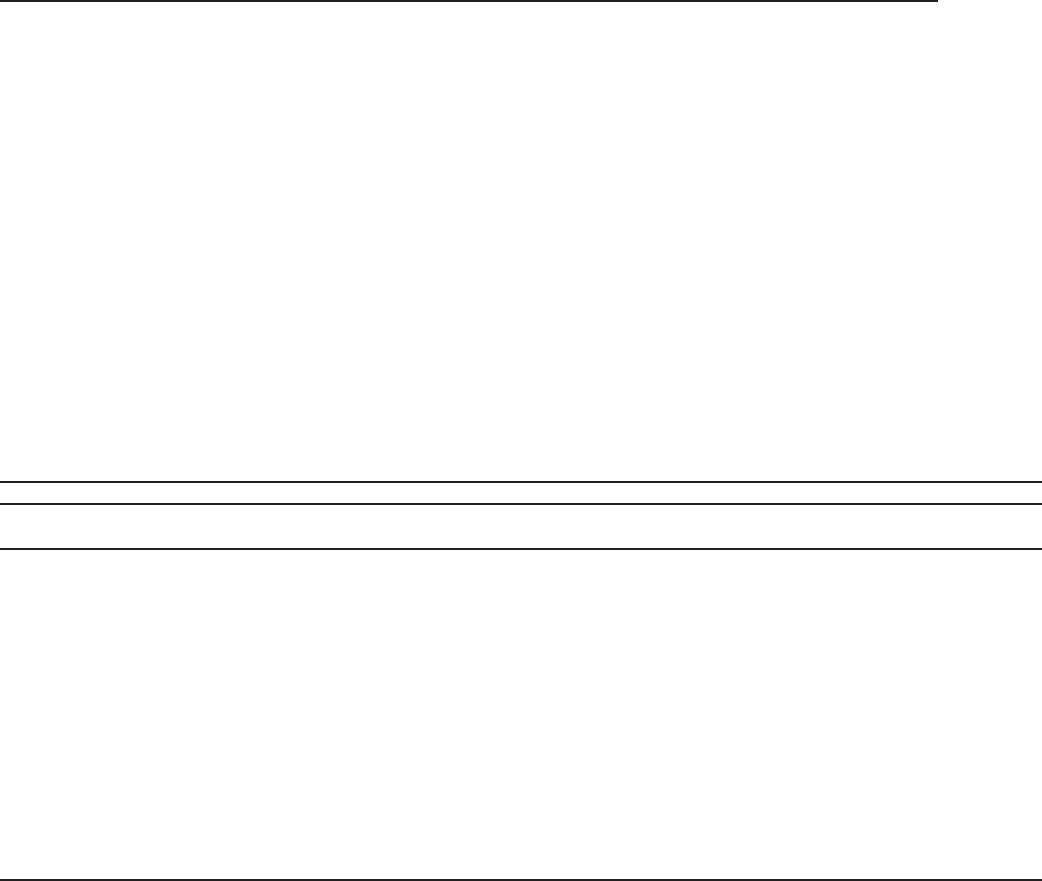
Intermediaries in International Trade
Table 10: E x change rates and firm-country exports (1 and 2), number of p roducts (3 and 4), average
exports (5 and 6) over time, by different type of firms, Extra-EU
Annual Differences
ln X
f ct
ln X
f ct
ln Prod
f ct
ln Prod
f ct
ln Avg X
f ct
ln Avg X
f ct
(1) (2) (3) (4) (5) (6)
D
W
f t
-0.015*** -0.001 -0.014***
(0.004) (0.002) (0.003)
ln Real Ex Rate
ct
-0.519*** -0.461*** -0.186*** -0.086** -0.333*** -0.375***
(0.150) (0.121) (0.047) (0.037) (0.107) (0.089)
∗D
W
f t
0.042* 0.017* -0.046** -0.046* 0.087** 0.064*
(0.026) (0.011) (0.023) (0.028) (0.039) (0.038)
Country FE Yes Yes Yes Yes Yes Yes
Year FE Yes No Yes No Yes No
Firm FE No Yes No Yes No Yes
Clustering Country-Year Country-Year Country-Year Country-Year Country-Year Country-Year
Adj R-squared 0.004 0.005 0.004 0.001 0.003 0.001
Observations 2483679 2483679 2483679 2483679 2483679 2483679
Countries 149 149 149 149 149 149
Firms 137262 137262 137262 137262 137262 137262
Note: Table reports results of regressions at the firm country level, using data on exports, number of products and
average exports b etween 2000 and 2007. The dependent and independent variables are defined as annual differences.
D
W
f t
is a dummy for wholesaler and ∗D
W
f t
is the interacted dummy. Robust standard errors clustered at country-year
level are reported in parenthesis below the coefficients. Asterisks denote significance levels (***: p<1%; **: p<5%;
*: p<10%).
34

Intermediaries in International Trade
Table 11: Exchange rates and firm’s exports, qu antity and unit value by produ ct and country over
time, by different type of firms, E x tra-EU
Annual Differences
ln X
f cpt
ln X
f cpt
ln Quantity
f cpt
ln Quantity
f cpt
ln UnitValue
f cpt
ln UnitValue
f cpt
(1) (2) (3) (4) (5) (6)
D
W
f t
-0.020*** -0.018*** -0.002***
(0.003) (0.004) (0.001)
ln Real Ex Rate
ct
-0.321*** -0.385*** - 0.287*** -0.353*** -0.035*** -0.032***
(0.095) (0.113) (0.100) (0.117) (0.011) (0.011)
∗D
W
f t
0.072* 0.065* 0.092** 0.090** -0.020* -0.025*
(0.039) (0.041) (0.041) (0.042) (0.012) (0.014)
Country FE Yes Yes Yes Yes Yes Yes
Product FE Yes No Yes No Yes NO
Year FE Yes Yes Yes Yes Yes Yes
Firm-Pr oduct FE No Yes No Yes No Yes
Clustering Country-Year Country-Year Country-Year Country-Year Country-Year Country-Year
Adj R-squared 0.004 0.004 0.004 0.001 0.004 0.001
Observations 4008339 4008339 4008339 4008339 4008339 4008339
Countries 150 150 150 150 150 150
Firms 119201 119201 119201 119201 119201 119201
HS6 Products 5201 5201 5201 5201 5201 5201
Note: Table reports results of regressions at the firm product country level, using data on exports, quantity and u nit
value between 2000 and 2007. The depend ent and independent variables are defined as annual differences. D
W
f t
is
a dummy for wholesaler and ∗D
W
f t
is the interacted dummy. Robust standard errors clustered at country-year level
are reported in parenthesis below the coefficients. Asterisks denote significance levels (***: p<1%; **: p<5%; *:
p<10%).
35

Intermediaries in International Trade
Table 12: Exchange rates and country exports, Extr a-EU
Annual Differences
ln X
ct
ln X
ct
ln X
ct
ln X
ct
(Above) Median Median Mean Mean
(1) (2) (3) (4)
D
W
c
0.0215 -0.004
(0.029) (0.032)
ln Real Exchange Rate
ct
-0.269** -0.499*** -0.232** -0.460***
(0.145) (0.162) (0.115) (0.145)
∗D
W
c
0.253* 0.511*** 0.224** 0.497***
(0.150) (0.164) (0.117) (0.147)
Year FE Yes Yes Yes Yes
Country FE No Yes No Yes
Observations 1489 1489 1489 1489
Adj R-squared 0.021 -0.057 0.020 -0.06
R-squared 0.028 0.062 0.028 0.063
Countries 160 160 160 160
Note: Table reports results of regressions at the country-year level, using data on exports between 2000 and 2010.
The dependent and independent variables are defined as annual differences. D
W
c
is a dummy that takes value 1 if
the intermediary export share to country c is above the med ian (mean) value of intermediary export share across
countries ∗D
W
c
is the interacted dummy. Robust standard errors are reported in parenthesis below the coefficients.
Asterisks denote significance levels (***: p<1%; **: p<5%; *: p< 10%).
36

Intermediaries in International Trade
Appendix
Firm trade data
ISTAT collects data on export transactions, which are the basic unit of observation for trade flows.
It is then possible to link tran sactions to firms u sing the value added tax identification code (partita
IVA) of the firm which is also recorded in th e transaction.
28
There are different requirements in
order for a transaction to be recorded. These requirements depend on the destination, Intra or
Extra-EU, and on the value of the tran sactions. The European Un ion sets a common framework
but leaves some flexibility to member states.
As far as Extra-EU transactions are concerned there is a good deal of homogeneity among
member states as well as over time. Since the adoption of the euro as a common currency, Italy set
the threshold at 620 euro (or 1,000 Kg), so th at all transactions bigger than 620 euro (or 1,000 Kg)
are recorded. All these records of Extra-EU transactions report complete inf ormation, that is, also
information about the product. From 2007 onward the threshold is at 1,000 euro (or 1,000 Kg).
Most of the existing differen ces are due to varying Intra-EU requirements. In 2003 there were
two reporting thresh olds : 200,000 euros
29
and 40,000 euros. Firms with more than 200,000 euros
of exports (based on the previous year) have to fill in the Intrastat document monthly. They report
complete information includ ing details about products. Firms with exports between 40,000 and
200,000 euros have to fill in the Intrastat form on a quarterly basis. The value of exports is recorded
but not information on products. Below 40,000 euros per year the transactions are not recorded.
Country and product data
In Section 3.2 we complement the firm-level trade data with country characteristics including proxies
for market size and variable and fixed trade costs.
To proxy transportation costs we use data on geographic distance taken from CEPII. Distances
are calculated following the great circle formula, which uses latitudes and longitudes of the most
important city (in terms of population) or of the official capital, if different.
As a pr oxy f or policy barriers we use a measure of country-level import tariffs. Tariff data are
taken from World Integrated Trade System (WITS), a project jointly developed by the World Bank
and UNCTAD. WITS contains the TRAINS database on bilateral tariffs at the six-digit level of
the Harmonized System (HS) product classification for about 5,000 products and 200 countries.
To generate a proxy for the market-specific fixed costs of exporting to a country, we use in -
formation from the World Bank Doing Business database (DB). The World Bank compiles pro-
cedural r equirements for importing a standardized container of goods by ocean transport. All
28
The value-added tax identification number also allows the linking of export data to various Censuses conducted
by ISTAT.
29
In 2007 this threshold was raised to 250,000.
37

Intermediaries in International Trade
documents needed by the exporters and importers in each country to trade goods across the border
are recorded, along with the time and cost necessary for completing the transaction (for details,
see Djankov et al.; 2011). For the purpose of the analysis three variables are used: number of
documents for importing in cludes all documents required per shipment to import th e goods from a
given destination; cost of importing measures the fees levied on a 20-foot container in US dollars;
time to import reflects the number of days needed to import a standard container of goods from a
factory in the largest business city to a ship in the most accessible port. Data are available from
2004 to 2010. Given the low variability of these indicators, we take the average value over the
available years.
To compute the real exchange rate used in Section 6 we use data from the International Financial
Statistics dataset (IMF, 2010). The official exchange rate available at IMF refers to the exchange
rate determined by national authorities or to the rate determined in the legally sanctioned exchange
market. It is calculated as an annual average based on monthly averages. Consumer price index
reflects changes in the cost of a basket of goods and services that may be fixed or changed at
specified intervals. The L aspeyres formula is generally used to compute such price index.
In addition to country characteristics, product and industry characteristics are also taken into
account. The firs t variable that we consider is a measure of ind ustry contract intensity developed by
Nunn (2007) to measure the importance of relationship-specific investment in intermediate inputs
across industr ies. Nunn’s data are classified according to the industry classification of the US I-
O table compiled by the Bureau of Economic Activity. To match each I-O industry to an HS6
product, first we use information from Lawson et al. (2002) to construct a concordance between
I-O industry classification and NAICS1997 cod e. Then the data are converted from NAICS1997
to NAICS2002. Finally, we exploit the concordance between Harmonize System Codes and NAICS
Industries developed by Pierce and Schott (2009) to obtain the information on contract intensity
at the level of HS6 product.
Principal Components
Tables A1 and A2 report the principal component analysis (PCA) on standardized variables for
Market Costs and Governance, respectively.
Because principal component is intended to study correlation patterns, it is first necessary to
standardize the variables of interest so that they all have the same variance. Without standardizing,
indeed, the principal component method would favor the variables with larger variances at the
expenses of those with smaller values.
The panel in the middle of Tab les A1 and A2 shows the total variance accounted by each
factor. The Kaiser criterion suggests to retain those factors with variance equal or higher than
1. In both cases there is only one factor that satisfies this criterion and this factor explain th e
38

Intermediaries in International Trade
77 percent and the 86 percent of the sum of all observed variances. The lower panel of the two
tables reports the factor loadings which are the parameters of the linear function that relates the
observed variables and the factor. T he higher the load the more relevant the variable in defining
the factor’s dimensionality. According to Table A1, the loadings on Factor1 are relatively large for
all the variables. The same holds when looking at Table A2. Finally, uniqueness is the variance
that is “uniqu e” to the variable an d not shared with others. Again all variables, in both tables,
have a low percentage of variance not accounted by other variables.
Table A1: PCA for Market Costs
Number of Obs. 180
Retained Factors 1
Number of Parameters 3
Variance Proportion
Factor1 2.30 0.77
Factor2 0.51 0.17
Factor3 0.18 0.06
Standardized Variables Factor1 Loadings Uniqueness
Number of documents for importing 0.81 0.34
Cost of importing 0.87 0.23
Time to import 0.93 0.12
Table A2: PCA for Governance Indicator
Number of Obs. 193
Retained Factors 1
Number of Parameters 6
Variance Proportion
Factor1 5.16 0.86
Factor2 0.4 0.07
Factor3 0.28 0.05
Factor4 0.09 0.01
Factor5 0.05 0.01
Factor6 0.03 0.01
Standardized Variables Factor1 Loadings Uniqueness
Voice & Accountability 0.86 0.25
Political Stability 0.85 0.27
Government Effectiveness 0.96 0.09
Regulatory Quality 0.95 0.1
Rule of low 0.98 0.05
Control of Corruption 0.96 0.09
39

Intermediaries in International Trade
References
Ahn, J., Khandelwal, A. K. and Wei, S.-J. (2011). The role of intermediaries in facilitating trade,
Journal of International Economics 84(1): 73–85.
Akerman, A. (2010). A theory on the role of wholesalers in international trade based on economies
of s cope, Research papers in economics, Stockholm University, Department of Economics.
Antr`as, P. and Costinot, A. (2011). I ntermediated trade, The Quarterly Journal of Economics
126(3): 1319–1374.
Bernard, A. B., Eaton, J., Jen sen, J. B. and Kortum, S. S. (2003). Plants and productivity in
international trade, American Economic Review 93(4): 1268–1290.
Bernard, A. B. and Jensen, B. J. (1995). Exporters, jobs, an d wages in U.S. manufacturing:
1976-87, Brookings Papers on Economic Activity: Microeconomics 1995: 67–112.
Bernard, A. B. and J ensen, B. J. (1999). Exceptional exporter performance: cause, effect, or both?,
Journal of International Economics 47(1): 1–25.
Bernard, A. B. and Jensen, J. B. (2004). Why some firms export, The Review of Economics and
Statistics 86(2): 561–569.
Bernard, A. B., Jensen, J. B., Redding, S. J. and Schott, P. K. (2007). Firms in international trade,
Journal of Economic Perspectives 21(3): 105–130.
Bernard, A. B., Jensen, J. B., Redding, S. J. and Schott, P. K. (2010a). Intrafirm trade an d product
contractibility, American Economic Review 100(2): 444–48.
Bernard, A. B., Jensen, J. B., Redding, S. J. an d Schott, P. K. (2010b). Wholesalers and retailers
in US trade, American Economic Review 100(2): 408–13.
Bernard, A. B., Redding, S. J. and Schott, P. K . (2010). Multiple-product fir ms and product
switching, American Economic Review 100(1): 70–97.
Bernard, A. B., Redding, S. J. and Schott, P. K. (2011). Multi-product firms an d trade liberaliza-
tion, Quarterly Journal of Economics, forthcoming .
Blum, B., Claro, S. and Horstmann (2011). Intermediation and the nature of trade costs: theory
and evidence, Unpublished, Rotman School of Management.
Blum, B. S., Claro, S. and Horstmann, I. (2010). Facts and figures on intermediated trad e, American
Economic Review 100(2): 419–23.
40

Intermediaries in International Trade
Djankov, S., Freund, C. and Pham, C. S. (2011). Trading on time, Review of Economics and
Statistics 92(1): 166–173.
Eaton, J., Kortum, S. S. and Kramarz, F. (2011). An anatomy of international trade: Evidence
from French firms, Econometrica 79(5): 1453–1498.
Felbermayr, G. and Jung, B. (2011). Trade intermediaries and the organization of exporters, Review
of International Economics 19(4): 634–648.
Helpman, E., Melitz, M. J. and Yeaple, S. R. (2004). Export versus FDI with heterogeneous firms,
American Economic Review 94(1): 300–316.
Helpman, E., Melitz, M. and R ubinstein, Y. (2008). Estimating trade flows: Trading partners and
trading volumes, The Quarterly Journal of Economics 123(2): 441–487.
Kaufman, D., Kr aay, A. and Mastruzzi, M. (2009). Governance matter VIII: Aggregate and indi-
vidual governance indicators 1996-2008, Policy Research Paper 4978, World Bank.
Lawless, M. (2010). Deconstructing gravity: trade costs and extensive and intensive margins,
Canadian Journal of Economics 43(4): 1149–1172.
Lawson, A. M., Bersani, K. S., Fahim-Nader, M. and Gu o, J. (2002). Benchmark input-output
accounts of the united states, Survey of Current Business 82: 19–108.
Mayer, T. and Zignago, S. (2005). Market access in global and regional trade, Working Papers
2005-02, CEPII research center.
Melitz, M. J. (2003). The impact of trade on intra-industr y reallocations and aggregate industry
productivity, Econometrica 71(6): 1695–1725.
Nunn, N. (2007). Relationship-specificity, incomplete contracts, and the pattern of trade, The
Quarterly Journal of Economics 122(2): 569–600.
Peng, M. W. and Ilinitch, A. Y. (2001). Export intermediary firms: A note on export development
research, Journal of International Business Studies 29(3): 609–620.
Petersen, M. A. (2009). Estimating standard errors in finance panel data sets: Comparing ap-
proaches, Review of Financial Studies 22(1): 435–480.
Petropoulou, D. (2007). Information costs, networks and intermediation in international tr ad e,
Economics series working papers, University of O x ford, Department of Economics.
Pierce, J. and Schott, P. (2009). A concordance between ten-digit U.S. Harmonized System Codes
and SIC/NAICS product classes and in dustries, Working Paper 155486, NBER.
41

Intermediaries in International Trade
Rauch, J. E. and Watson, J. (2004). Network intermediaries in international trade, Journal of
Economics & Management Strategy 13(1): 69–93.
Roberts, M. J. and Tybout, J. R. (1997). The decision to export in Colombia: An empirical model
of entry with sunk costs, American Economic Review 87(4): 545–64.
Silverman, B. W. (1986). Density Estimation for Statistics and Data Analysis, London: Chapman
& Hall/CRC.
42
